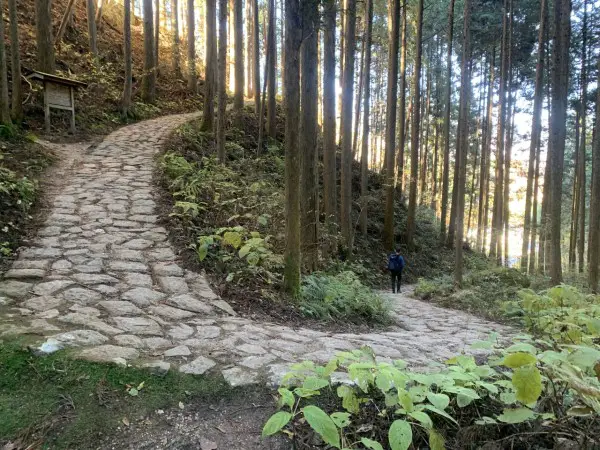
The Nakasendo (中山道) —the ‘Central Mountain Route’— is an old route connecting Edo (present-day Tokyo) with Kyoto, travelled by samurai during the Edo period. Although much of the original Nakasendo has been lost, replaced by modern highways, you can still enjoy remnants of the historic route in the Kiso Valley. The most famous section runs from Magome to Tsumago on the border of Gifu and Nagano prefectures. If you want to experience the charm of old Japan, with beautifully preserved post towns with historic wooden houses and stone paths, while enjoying Japan’s enchanting and peaceful countryside, hiking the Nakasendo Trail may be exactly what you are looking for!
Most tourists choose to hike the very picturesque but short section of the route from Magome to Tsumago and then take a train to the famous historic town of Narai. However, if you want to get to know Japan off the beaten track, travel the longer section of the trail on foot like a real samurai 😉 Honestly, I don’t think that the less touristy sections of the Nakasendo route described on this blog are less interesting. So if you have a little extra time, spend 3 days hiking the Nakasendo Trail. Of course, if you have less time, a day trip from Nagoya and hiking from Magome to Tsumago will also give you a taste of old Japan. In both scenarios, you will find all the details in this blog.
What's in this blog post?
> The historical importance of the Nakasendo Trail
There were five official routes (Gokaido) used by the shōgun, daimyō (feudal lords controlling the provinces of Japan) and samurai during the Edo period (1603 – 1868). One of these five roads was the Nakasendō Trail, extending through the mountains from Edo, the base of the shōgun holding the actual power, to Kyoto – the city of the Emperor and Japan’s capital for 1000 years.
While the most popular road featuring a mild climate – Tokaido – ran along the coast, the Nakasendo cut through mountain ranges. Despite the challenging mountain passes, many travellers preferred the less crowded Nakasendo because it did not involve river crossings.
Post Towns on the Nakasendo Trail
Because the 540-kilometre Nakasendo Trail was usually traversed on foot, it consisted of 69 post towns (called juku in Japanese) along the ancient route. Post towns were established to provide travellers with rest, accommodation and meals during a long and tiring journey. The wooden architecture of Magome, Tsumago and Narai has been carefully preserved, making them the most charming and authentic post towns on the Nakasendo Trail.
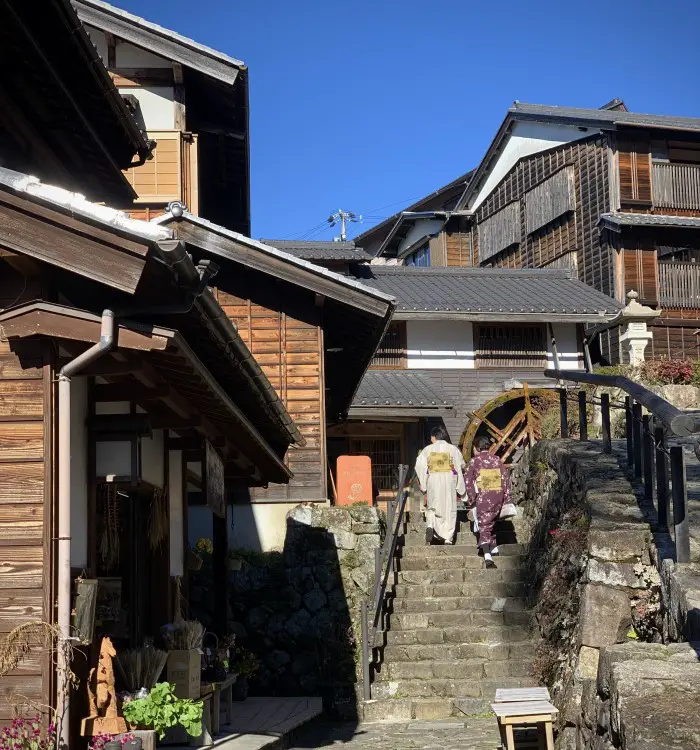
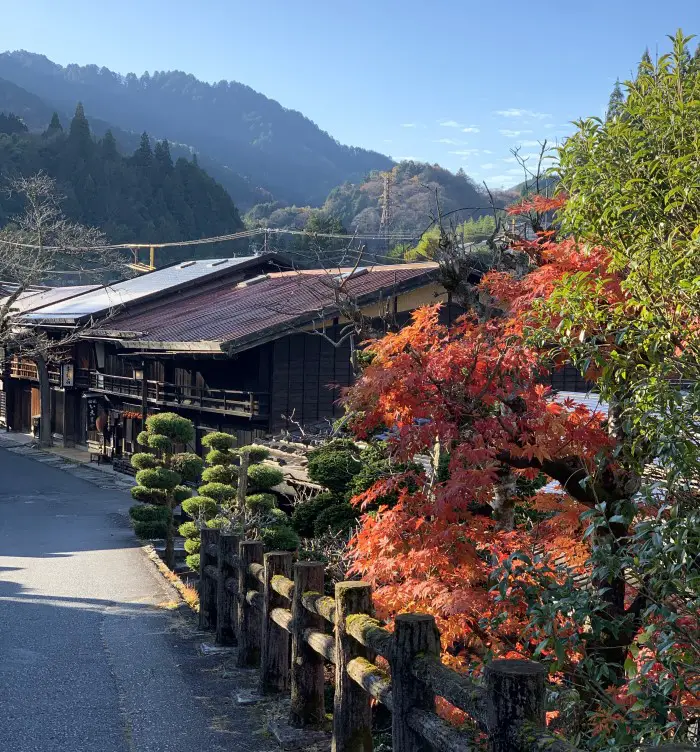
While Nagoya is the closest major city to Magome, Narai is relatively close to the city of Matsumoto. More details on how to get to the starting point of the Nakasendo trail can be found later in the article.
> 5 reasons to hike the Nakasendo Trail
1. Walking along a historic trail is like travelling in time.
Hiking the historic Nakasendo Trail is a wonderful way to experience old Japan and delve into its fascinating history. It’s not just an ordinary mountain hike; it is a journey that both nature lovers and history buffs will appreciate. Walking along stone paths covered with moss to the charming post towns with carefully restored wooden architecture from the Edo period, where samurai once roamed, is a journey back in time.
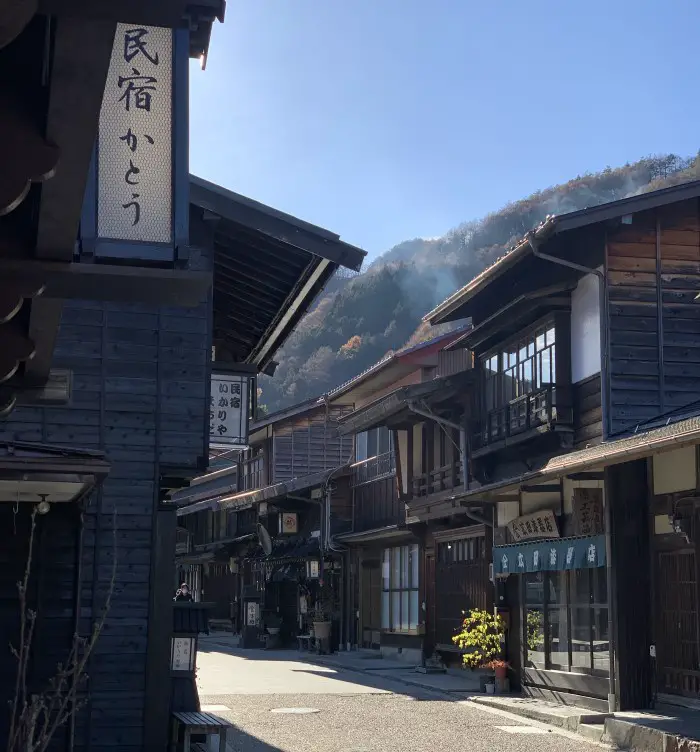
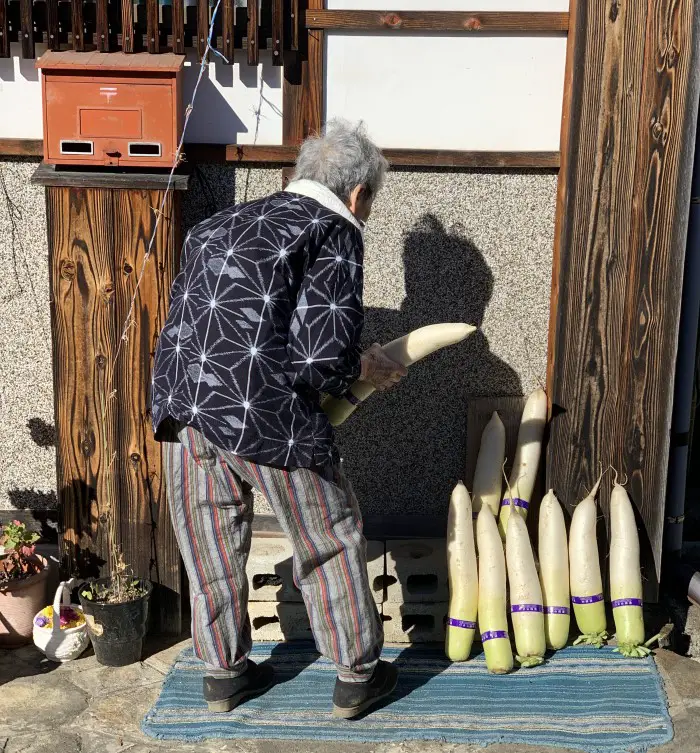
2. A great nature escape from the crowds in large Japanese cities.
Japanese cities, filled with neon lights and restaurants, are likely what brought you to the Land of the Rising Sun. However, after a few days spent in bustling Tokyo, Osaka, and Kyoto, nothing recharges batteries better than a short break in nature. Hiking the Nakasendo Trail allows you to discover Japan’s diverse landscapes – forests with a mix of ancient cedar and bamboo trees, rural scenery dotted with rice fields and old Japanese farmhouses, and mountains stretching to the horizon. This is real Japan off the beaten path.
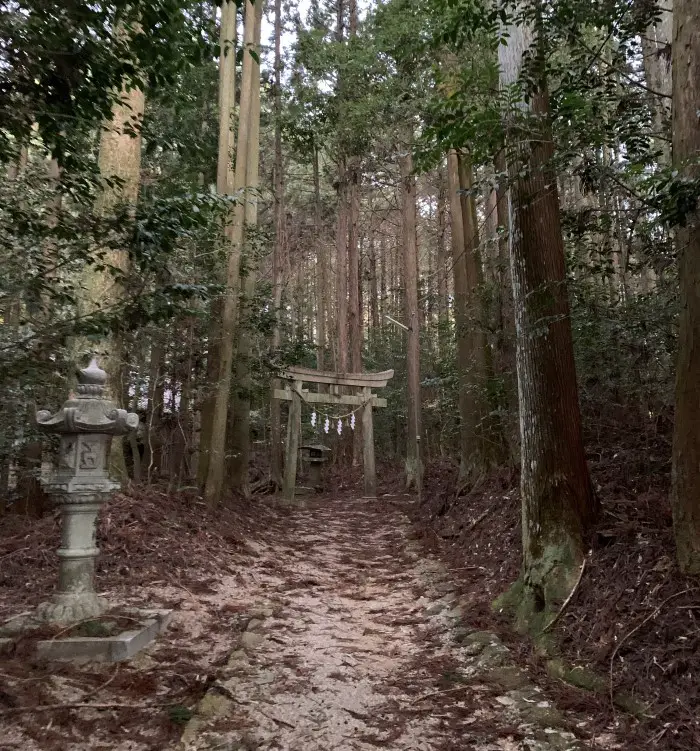
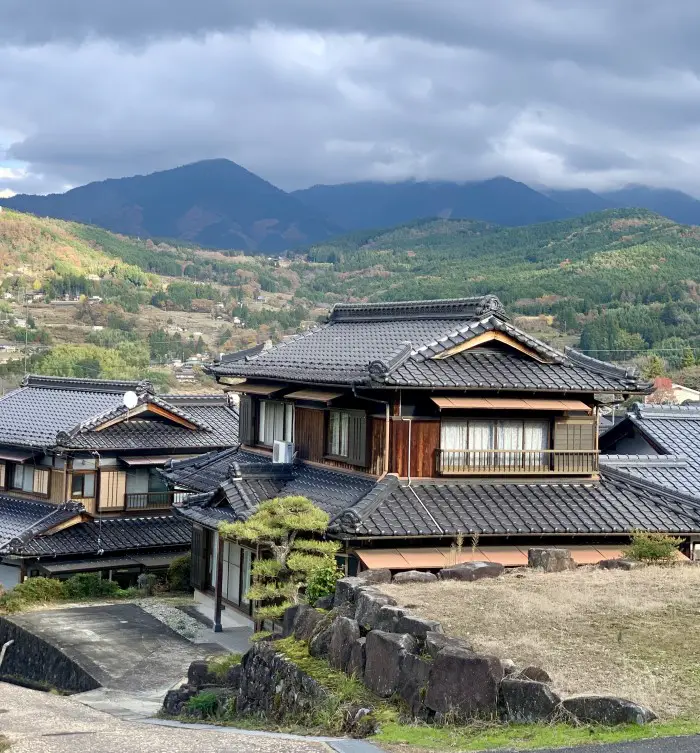
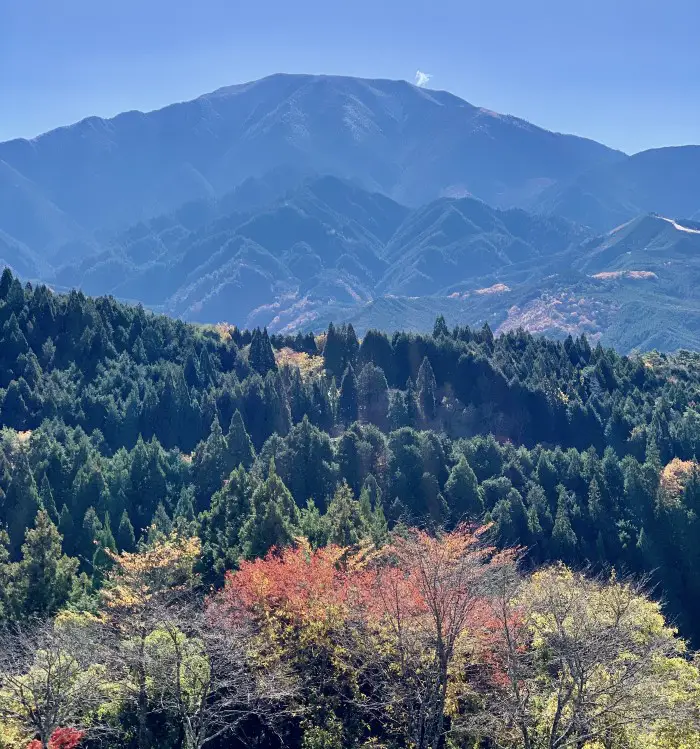

The Nakasendo Trail is especially beautiful in the fall, when you can enjoy the foliage, and in the spring, when the cherry blossom trees line the trail. But one of the best features of Nakasendo Trail hiking is that you can do it all year round!
3. Hiking the Nakasendo Trail independently is very easy.
The route is easy and very well marked, so it’s impossible to get lost. In addition, on some sections colourful spots marking the ground make navigation even easier.
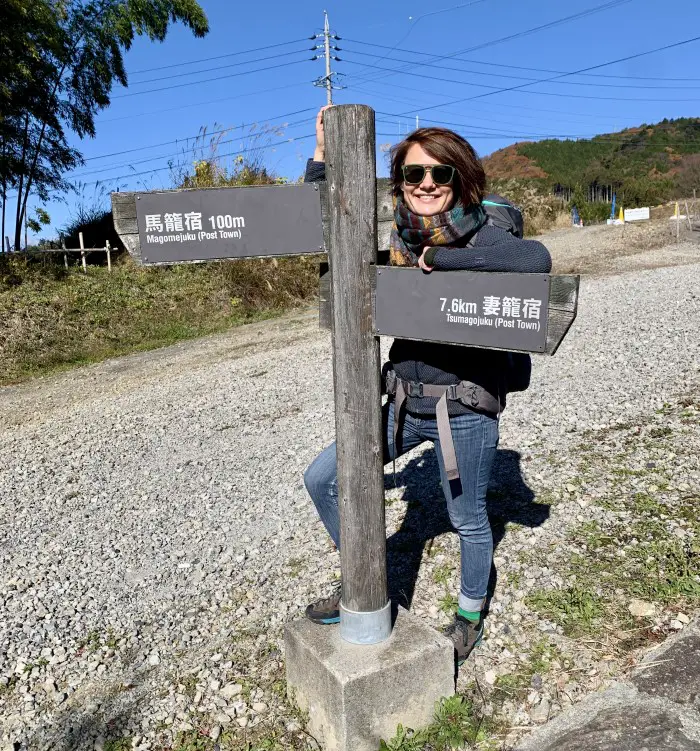
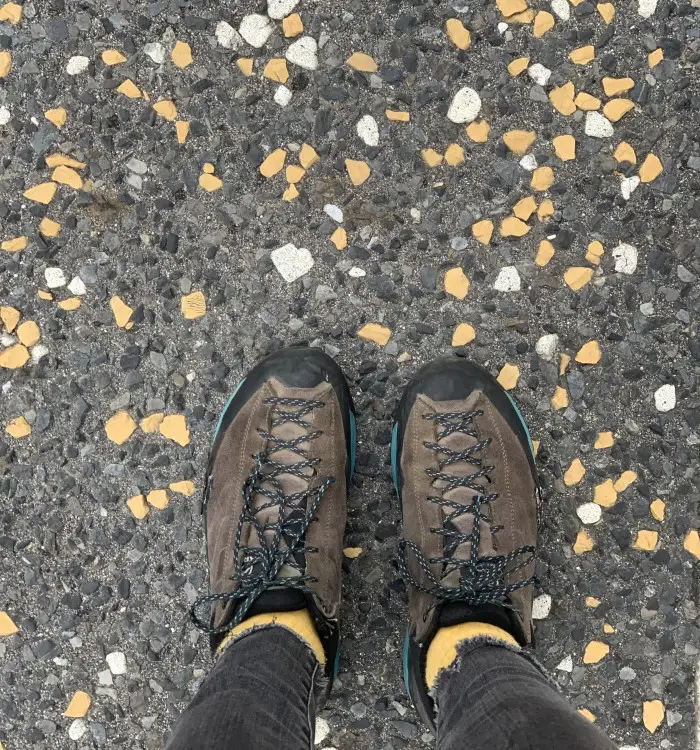
There are only a few small hills. You don’t need any special equipment or skills. People of all ages and fitness levels, including beginners, can complete this hike. Just put on your favourite, comfortable walking shoes and hit the trail!
4. Excellent infrastructure and easy access to the Nakasendo Trail.
It takes about 50 minutes by train to reach Nakatsugawa from Nagoya, and only 40 minutes to Narai from Matsumoto. This is very convenient even for a one-day trip. Not only post towns along the Nakasendo Trail provide all you need from comfortable guest houses, local cuisine and plenty of souvenir shopping opportunities. There are also some lovely tea shops where you can take a break along the way. Toilets are easily available, clean and marked well.

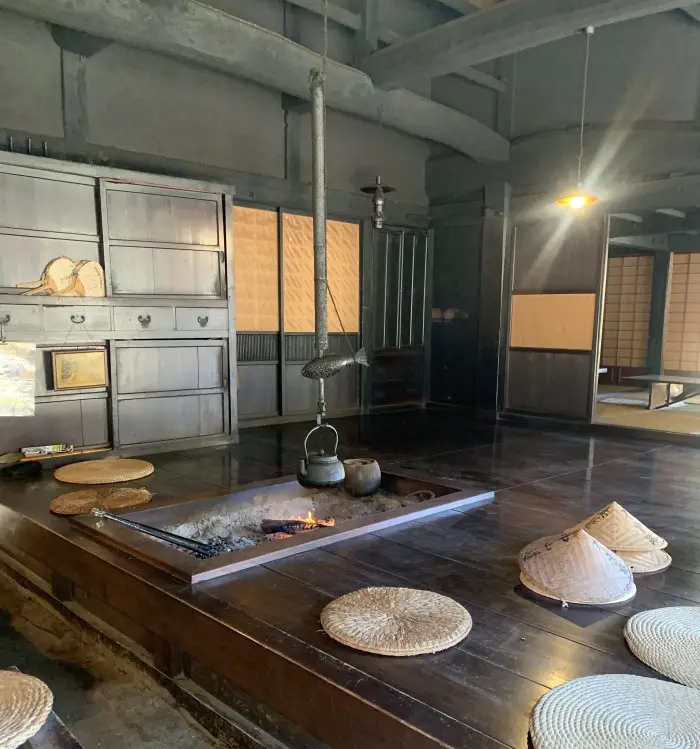
5. Affordable baggage forwarding services make hiking easy.
Luggage forwarding services are available at tourist information centres and can also be booked through hotels along the Nakasendo Trail. Luggage dropped off in the morning in one post town can be picked up in another for a small fee (~¥1,000). This means that even if you have heavy luggage, you can still enjoy hiking without worries. Welcome to Japan – the country of ultimate convenience! 🙂
> Nakasendo Trail as a day trip from Nagoya
If your time is limited, take a day trip to the Nakasendo Trail. Hiking the most popular 8km section of this old route from Magome to Tsumago takes only about 3 hours at a leisurely pace.
The journey begins in Japan’s fourth largest city – Nagoya, located between Tokyo and Kyoto, from where it takes about 1.5 hours to reach the trailhead in Magome. It’s best to set off early in the morning. From Nagoya take a train to Nakatsugawa (50 minutes) and then a bus from Nakatsugawa to Magome (30 minutes). After visiting Magome, you will arrive on foot in Tsumago at lunchtime, where you can stay overnight or return to Nagoya. There are various possibilities to extend this itinerary by adding shorter sections of the Nakasendo Trail. The sections from Ochai-juku to Magome-juku or Tsumago-juku to Nagiso are both short and scenic!
Instead of returning to Nagoya, you can also go to one of my favourite cities in Japan – Matsumoto with its beautiful black castle. In this case, it is best to ship large luggage from Nagoya to Matsumoto using the hotel’s luggage shipping service or directly through YAMAMOTO.
Yamamoto luggage forwarding services
For more information, read this detailed 3-day Nakasendo Trail itinerary to choose the parts of the route that suit you best and plan your trip well.
> Nakasendo Trail 1-day hiking itinerary from Nagoya
It’s easier to hike from Magome to Tsumago rather than the other way round due to shorter uphill sections.
8:00 – 8:50 Travel by Limited Express train from Nagoya to Nakatsugawa
9:10 – 9:40 Bus trip from Nakatsugawa Station to Magome
9:40 – 11:00 Explore Magome-juku
11:00 – 14:00 Hike from Magome to Tsumago
14:00 – 15:20 Quick lunch and sightseeing of Tsumago-juku
15:25 – 15:35 Bus transfer to Nagiso
15:55 – 17:07 Travel by Limited Express train from Nagiso to Nagoya
But if you have more time, hike nakasendo trail for 2-3 days to explore its hidden gems.

> Hiking Nakasendo Trail in 3 days - summary
(Rotate the screen for landscape mode to see the full table with details of each hiking day.)
Day | Section | Distance | Time (incl. breaks) | Elevation gain | Description |
1 | Nakatsugawa – Magome | 8.5 km | 3 h 30 min | 270m up | The longest of the described sections features the most diverse scenery. There are several ascents and descents along the route. You will pass villages with typical rural scenery, a lovely tea house, several small shrines and a cobblestone path from Ochiai-juku |
2 | Magome – Tsumago | 8 km | 3 h | 190m up 370m down | The most popular route, connecting two charming post towns, is also the easiest and the most crowded. It includes a gentle ascent to Magome Pass (790m) at the beginning of the hike, with a pleasant tea shop halfway up and a short stone path. |
3 | Tsumago – Nagiso | 4km | 50 min | Flat | A short hike through peaceful countryside instead of a 10-minute bus ride. |
Yabuhara – Narai | 5.5 km | 2 h | 280m up 270 m down | Hiking the forest trail to the Torii Pass (1197m) and descending to Narai offers a visit to a beautiful shrine and mountain views along the way. More nature than rural scenery. | |
TOTAL | 26 km | 9h 20 min |
> 3-day Nakasendo Trail hiking - day by day itinerary
> DAY 1: Hiking from Nakatsugawa-Juku to Magome-Juku
What to visit in Nakatsugawa-Juku?
After getting off the train, visit the Information Centre to pick up some maps. It is a big building on the left side from the station, impossible to miss. From there, it’s just a 10-minute walk to the historical centre of Nakatsugawa – the remnants of the post town – Nakatsugawa-Juku. We visited the long-established Kawakamiya shop selling traditional Japanese sweets made with chestnut – kurikinton. The sweets are truly unique, beautifully wrapped, and make for a nice gift. We bought individual pieces for a snack during our hike.
The Japanese art of turning sweets into... art
Chestnut beauties in Nakatsugawa-Juku
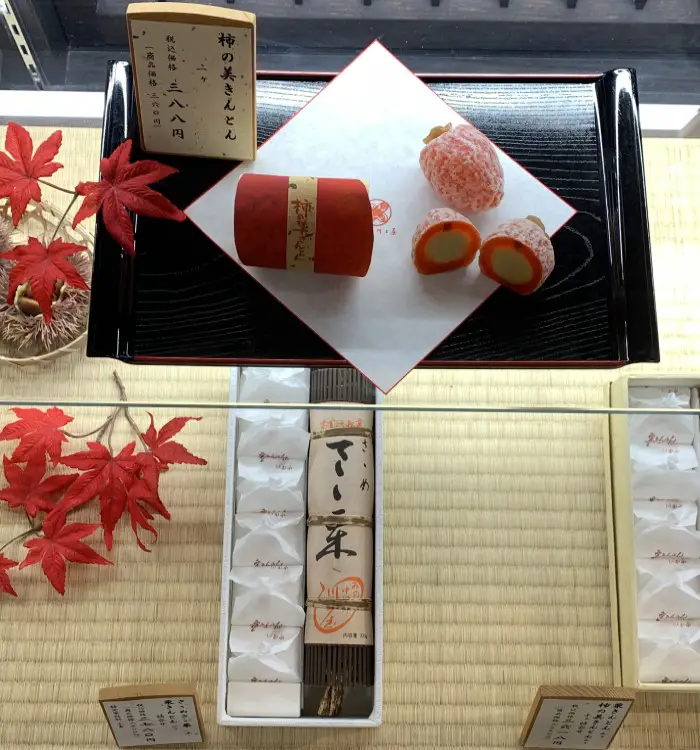
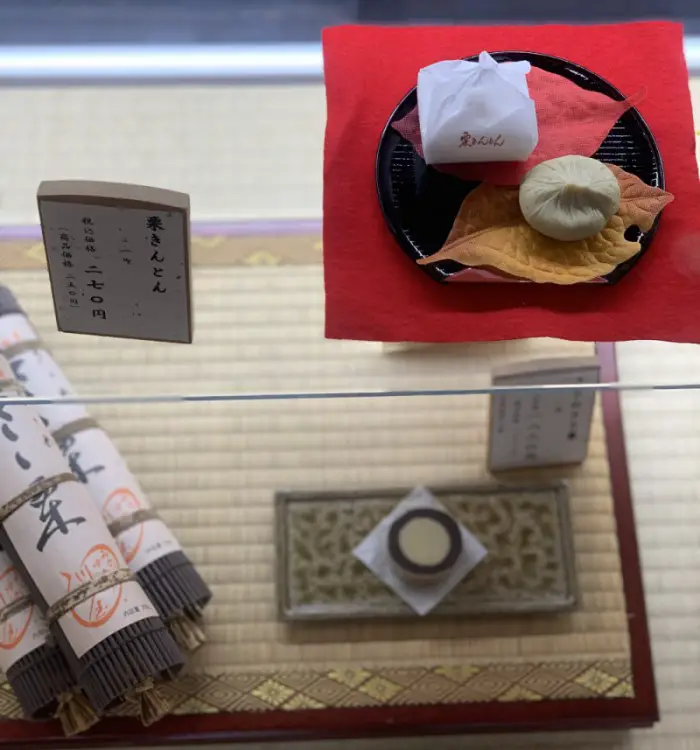
Next, we headed to Hazama Sake Brewery, which has been brewing sake for centuries. We had a pleasant chat with a friendly man (for moments like these I haven’t given up on learning Japanese yet), who offered us some sake for tasting. We also bought a small bottle of sake, which we enjoyed two days later on our last night in Narai-Juku. It was delicious! Since you won’t find typical convenience stores in the post towns along the trail, and everything closes early, stocking up on a small bottle of sake might be an even better idea than buying chestnut sweets. Well, of course, it depends on who likes what, it’s just a suggestion 😉
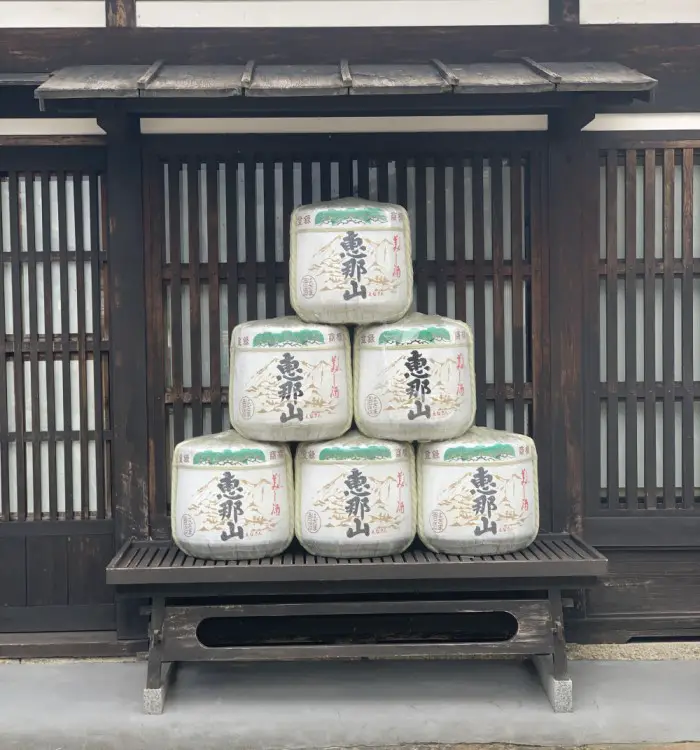
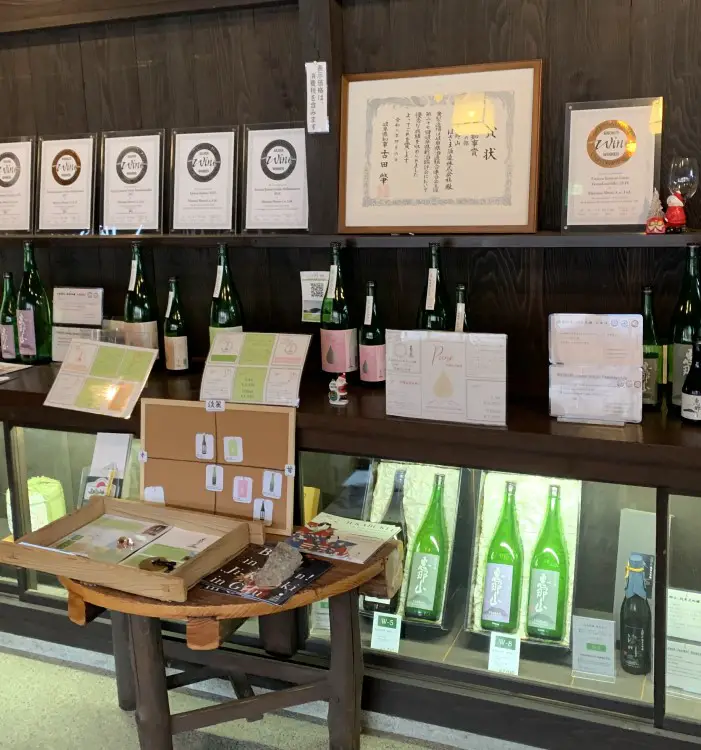
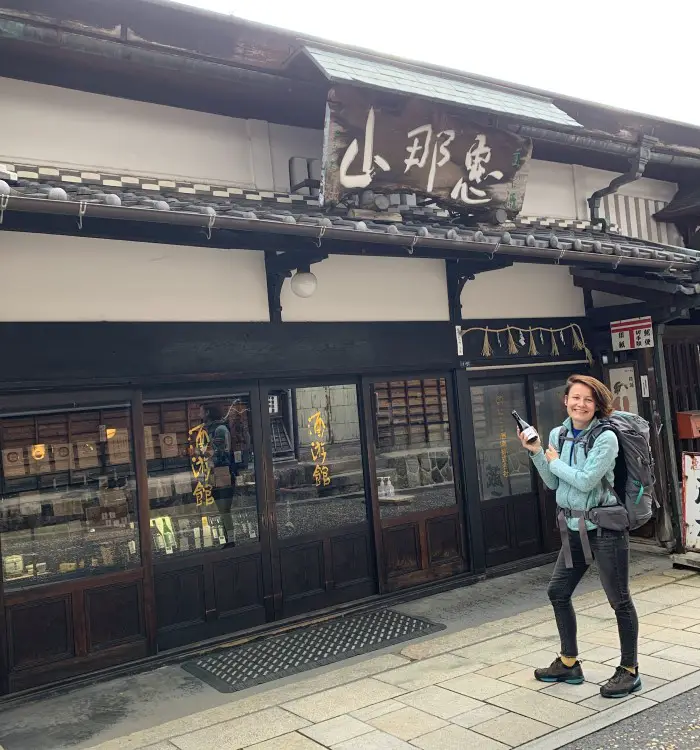
Visiting sake brewery is such a unique way to start your hiking trip!
Hiking from Nakatsugawa-Juku to Ochiai-Juku
We walked at a leisurely pace through the town of Nakatsugawa-Juku, following the wooden Nakasendo Trail signs and the colourful markings on the ground that made navigation even easier. It was already the end of November, so the autumn colours were amazing! We stopped in Asahigaoka Park to visit a tiny shrine painted bright red with a row of picturesque torii gates.
when your car matches the colour of the shrine in front of your house... 🙂 Everything around asahigaoka park was red!
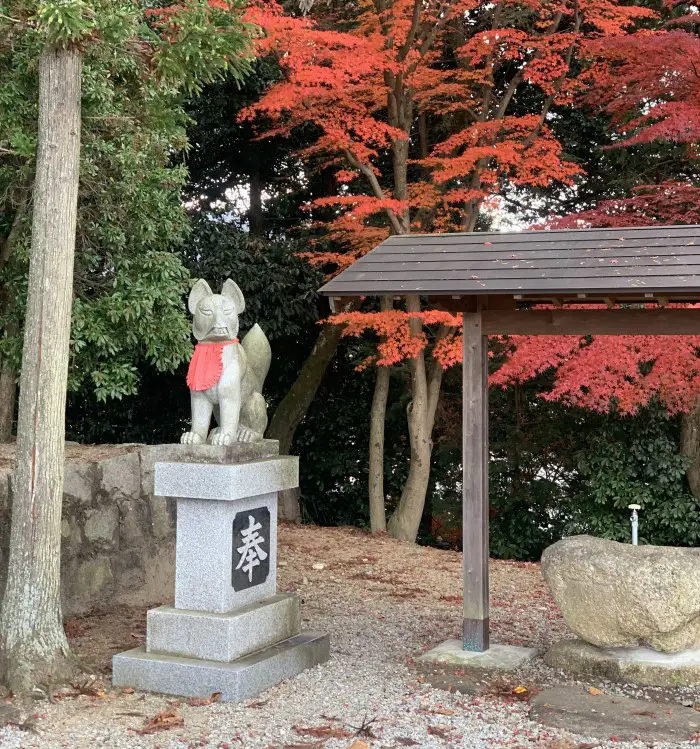
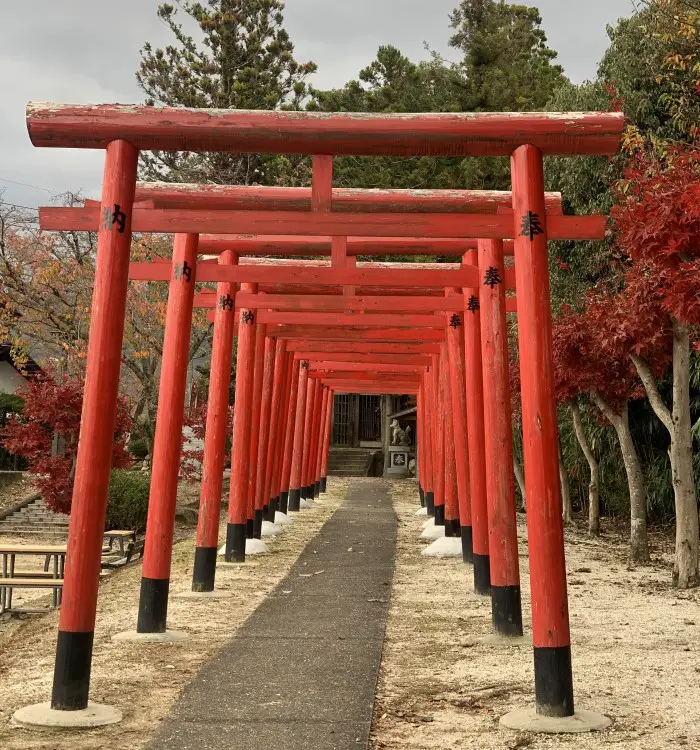
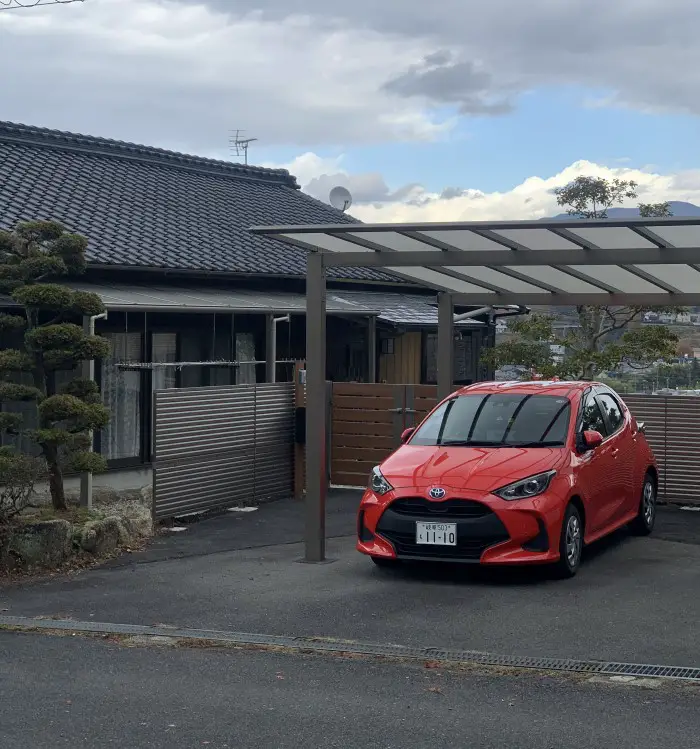
While passing through the peaceful countryside, we often encountered smiles and greetings from local residents. At one point, an elderly man ran up to us to give me beautiful flowers he had just picked from his garden. I was stunned! You will never experience such a sincere and warm welcome in large Japanese cities, where you are just one tourist among many. This is only possible off the beaten track.
Before entering Ochiai-Juku, we took a short break in front of Echizenya, a charming teahouse famous for its excellent coffee and mochi, located in a traditional wooden building. However, we decided to rest outside without going in as it was only going to be a short break.
Flowers from a stranger & a century-old teahouse protected by adorable tanuki Japan off-the-beaten off-track
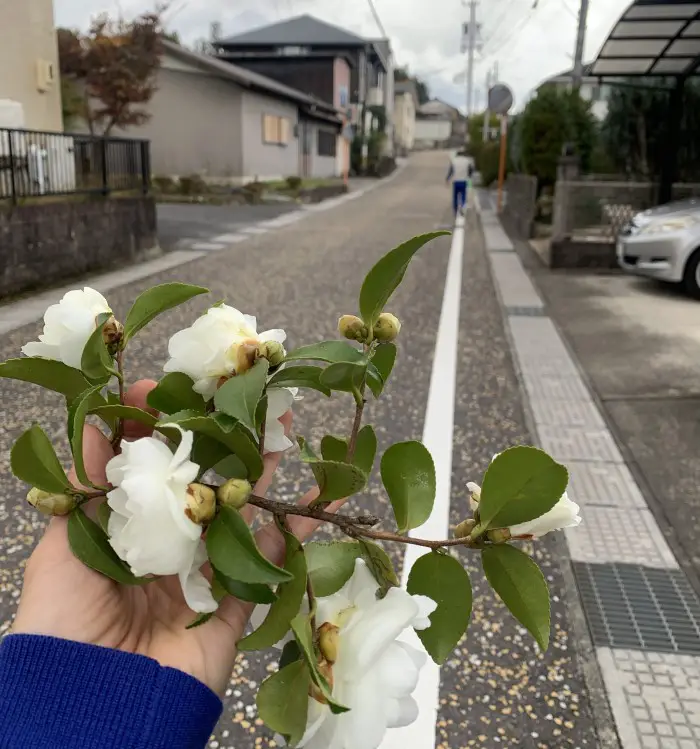
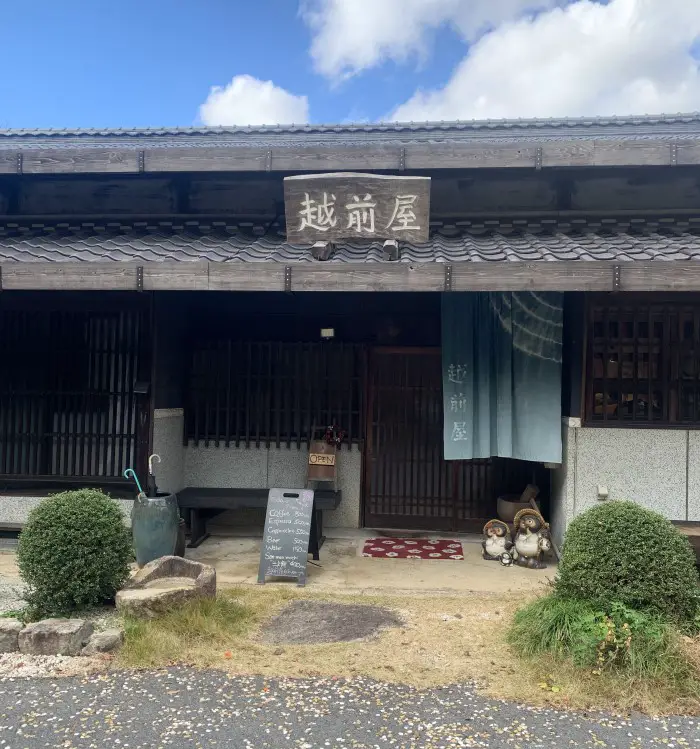
Passing through Ochiai-Juku on the Nakasendo Route
In Ochiai-Juku, the 44th post town on the Nakasendo route from Edo to Kyoto, you can visit the Craft Laboratory, offering various crafts and artistic experiences. Unfortunately, it was closed during our visit. If you have more time, you can visit the peaceful Buddhist temples – Zenshoji and Kofukuji. Although Ochiai-Juku is not as impressive as other post towns, its Honjin (the official inn for dignitaries travelling in Nakasendo) has been preserved in its original state.
While passing through the town, we visited one more red shrine and reached one of the highlights of the first day – a beautiful moss-covered cobblestone path. Walking 840-metre path through picturesque bamboo forests, and allows you to travel back in time.
Hiking Nakasendo Trail from Nakatsugawa-Juku to Ochiai Juku
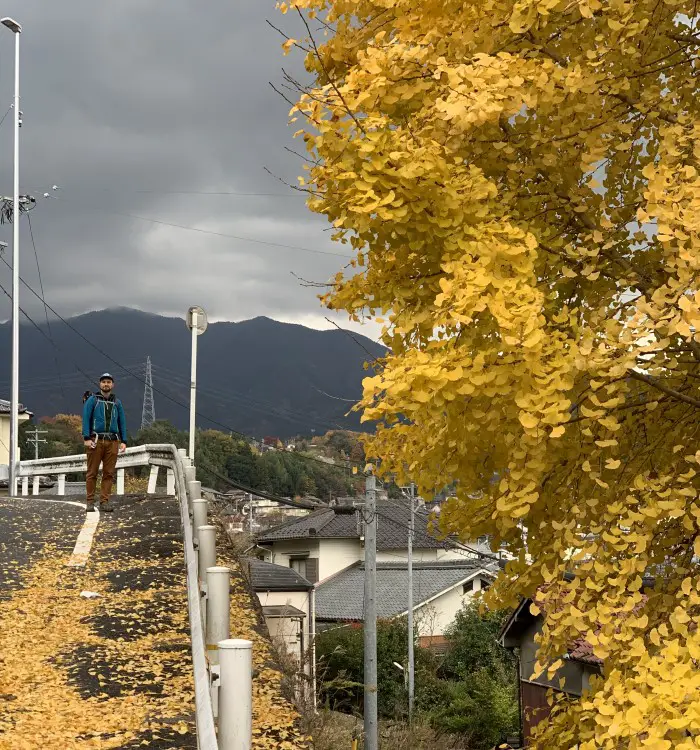

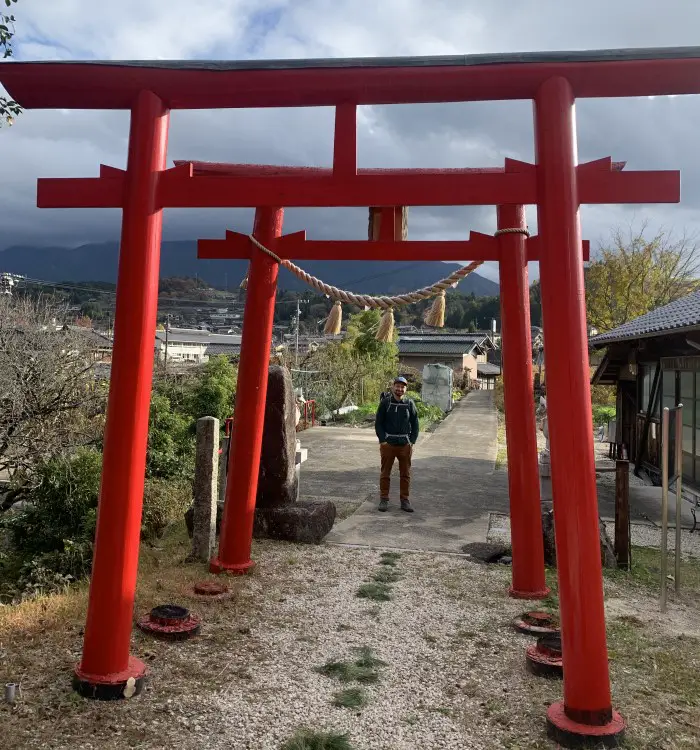
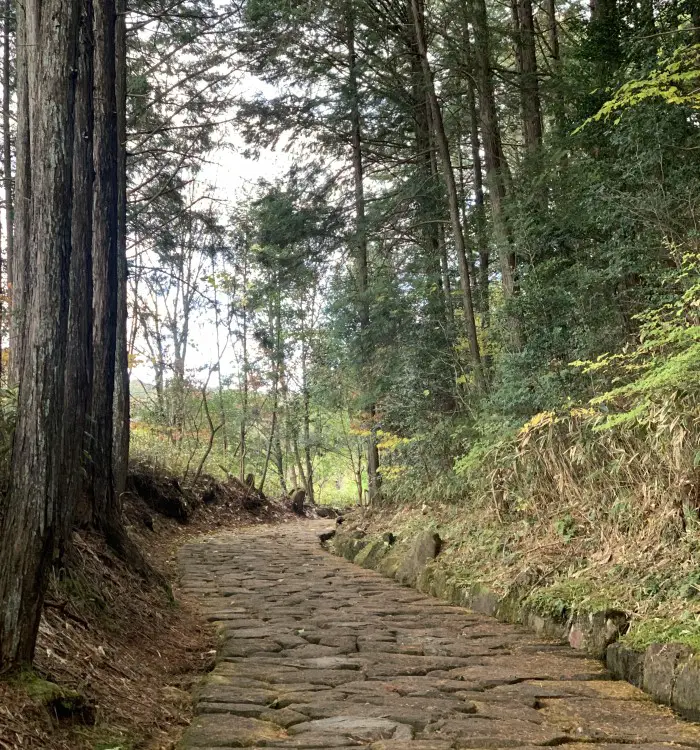
Arriving to Magome
During the last half an hour the rural scenery, mountains hidden behind low-hanging clouds and the setting sun were fantastic. Just before entering Magome-Juku we stumbled on the next gem – a little shrine with a truly stunning torii gate and a momiji tree.
We arrived in Magome feeling grateful that we had chosen to walk instead of taking a 30-minute bus ride. It was a truly stunning day. Reaching the post town on foot, situated along an ancient route that has been traversed by walkers for centuries, felt like the only right way.
If your time is limited, you can shorten your trip by taking a bus from Nakatsugawa to Ochiai-Juku. Get off at this bus stop, to enjoy the final section of the hike with the stone path and arrive at Magome on foot.
Hiking Nakasendo Trail from to Ochiai-Juku to Magome
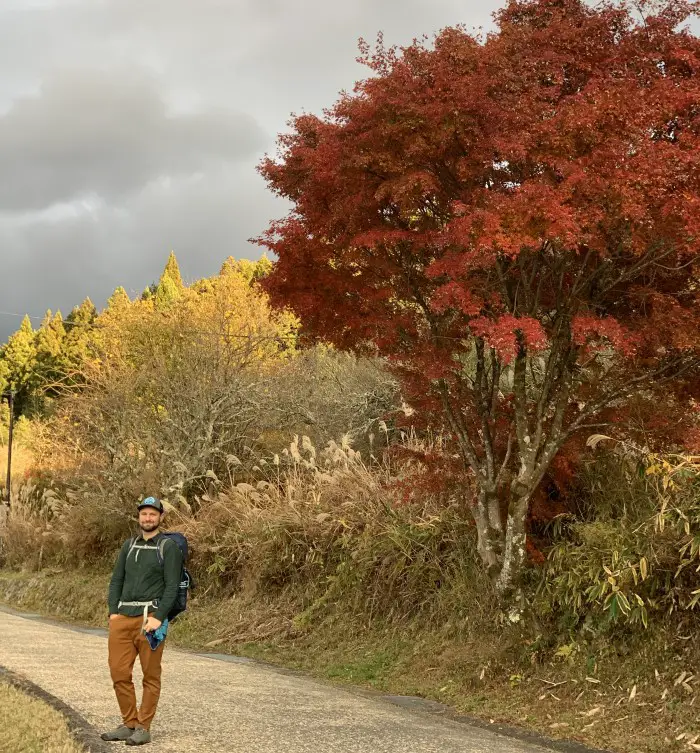

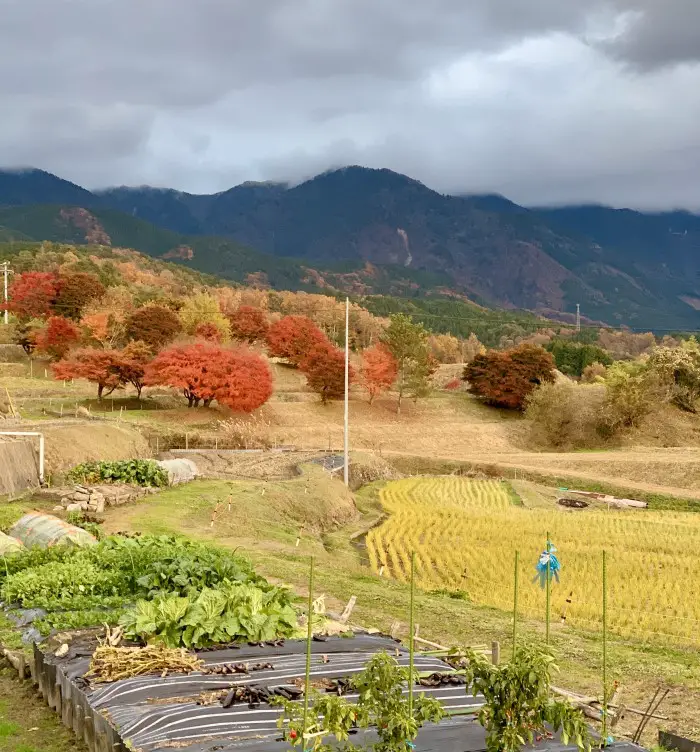
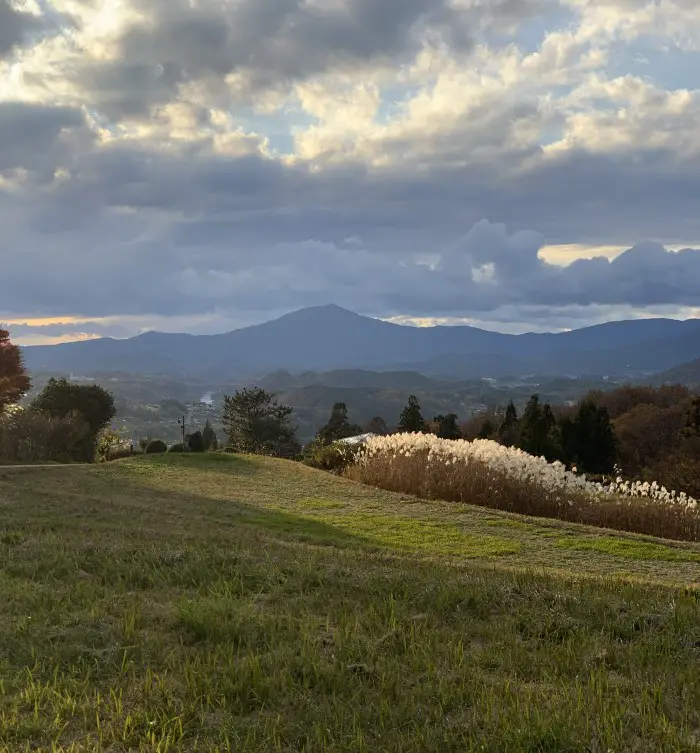
>> Magome travel guide
What if I told you that walking along the steep stone path in Magome felt a bit like walking through the Himalayan villages in my beloved Nepal, would you believe me? Situated at an altitude of 600 m, Magome is higher in the mountains than the other beautifully restored post towns you will visit on the Nakasendo Trail. There was something about the stone path, the mountain air and the cafes that reminded me of some Himalayan villages.
What to do in Magome?
While visiting Magome, apart from enjoying the mountain air and views, as well as visiting charming souvenir and coffee shops, you can pay a visit to Honjin. Back in time it served as the main inn of a post town, and in addition, was the birthplace of the famous Japanese writer, Shimazaki Toson. We spent too much time window shopping in Magome and had no time for Honjin. But no worries, we visited Tsumago’s Honjin instead.
Magome is My favourite Nakasendo Trail post town
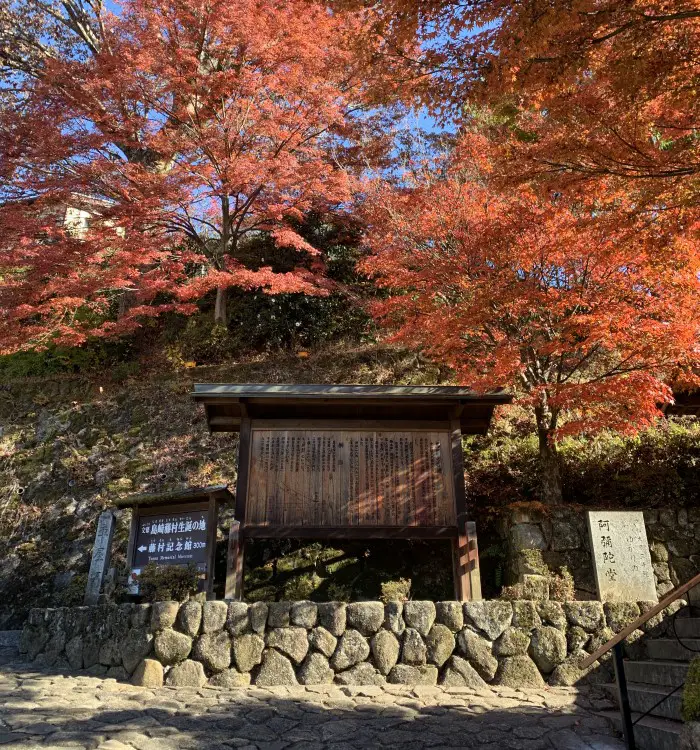
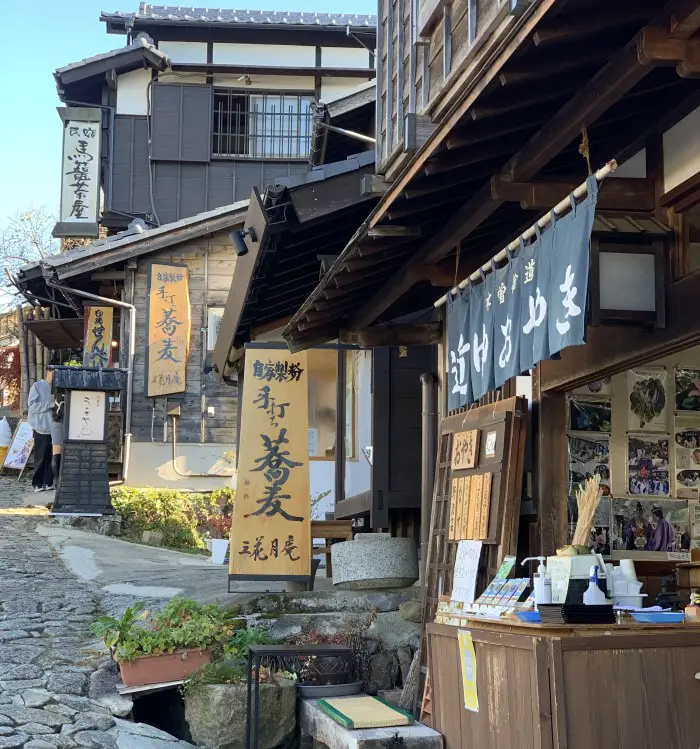

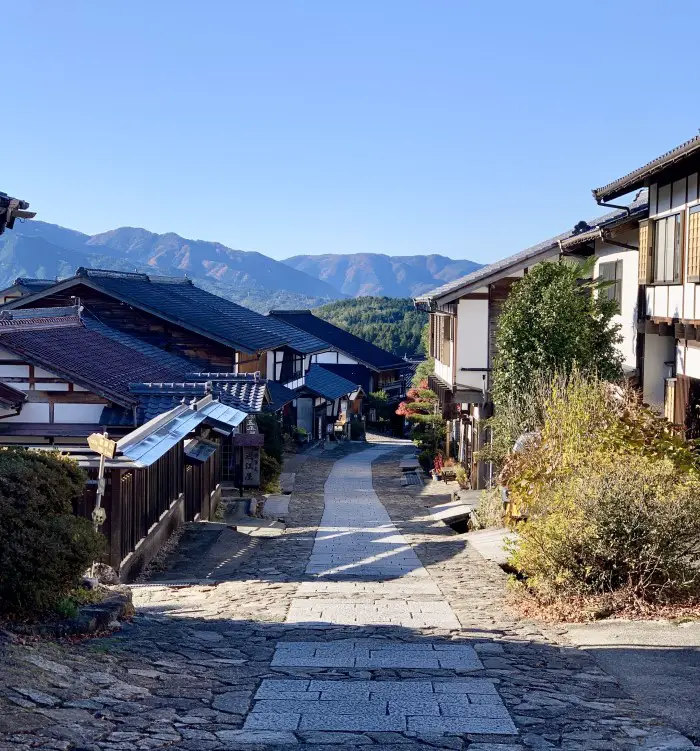
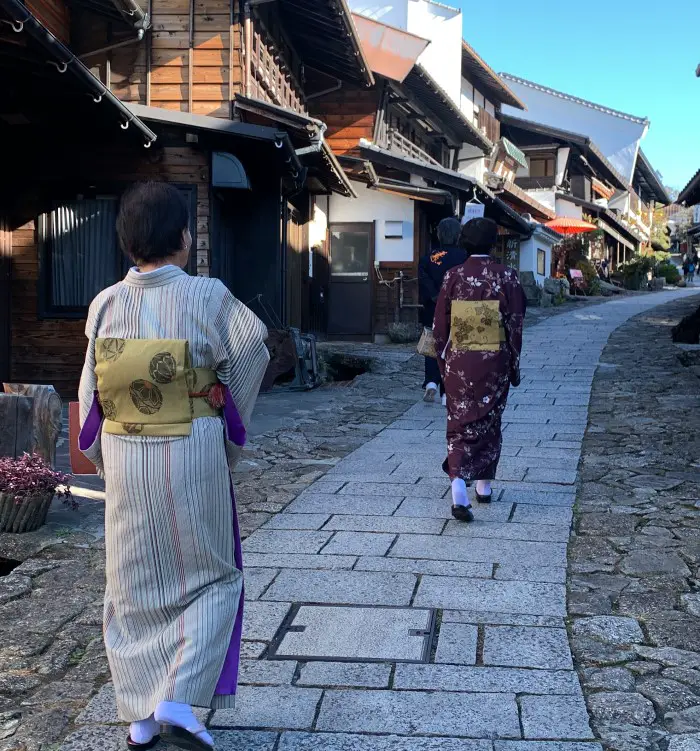
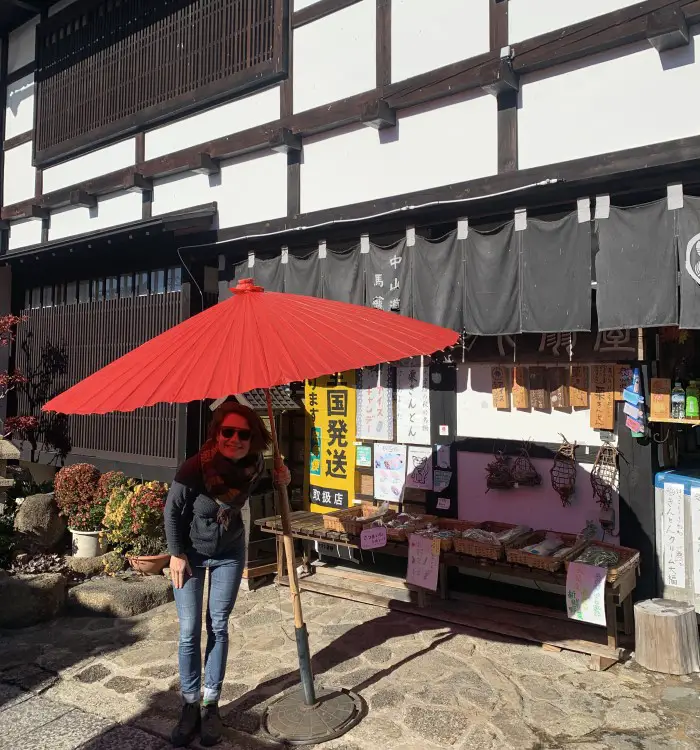
Where to stay in Magome?
In general, on the Nakasendo Trail book your accommodation in advance, as there aren’t that many options available on main booking platforms. If you’re comfortable searching on Google Maps for accommodation, which does not offer online booking, and making a phone call to reserve a room (that’s what I did in Tsumago), you will have more options. But if you prefer booking online, do it early, especially if you’re hitting the trail on the weekend.
We were lucky to secure a spot at the Nedoko Guesthouse, which I loved. Centrally located on the main street, it offers traditional Japanese-style rooms with mountain views. This guesthouse is very affordable, and has English-speaking staff. What more could you need? Since dining isn’t available at Nadeko, after booking a room, you will receive an email with detailed information about all dining options in Magome (I think there are three :)) and assistance in booking them.
Nedoko Guesthouse in a great option to stay in Magome
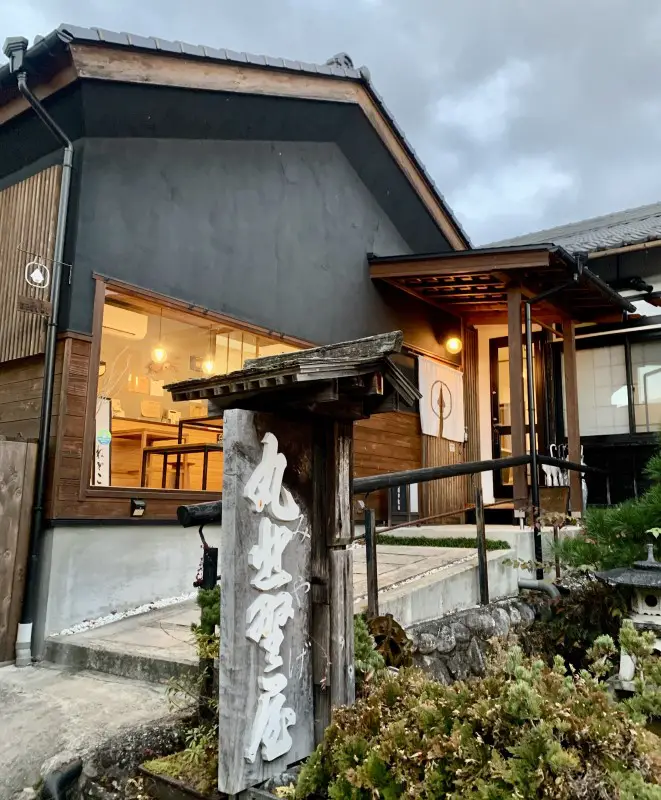
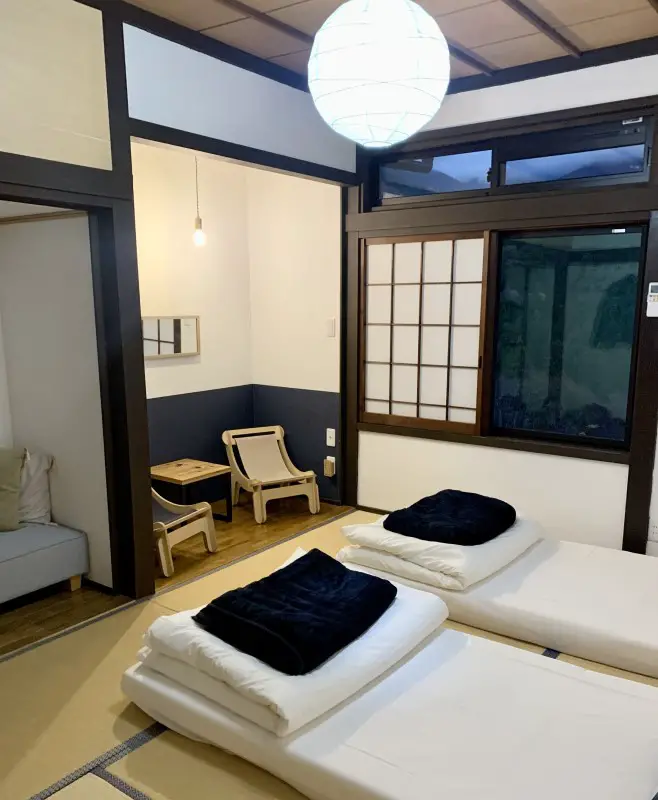
Where to eat in Magome?
Food options at Magome are limited, but what we ate was incredibly good.
Breakfast / Coffee
HILLBILLY COFFEE COMPANY
HillBilly Coffee Company serves delicious coffee, croissants and sandwiches, which is a great option in the morning. If you are an Italian living in Asia for over 10 years, you will feel like you are in heaven 😉 The cafe is located right in front of the main symbol of Magome, an old mill with two water wheels, which is so nice!

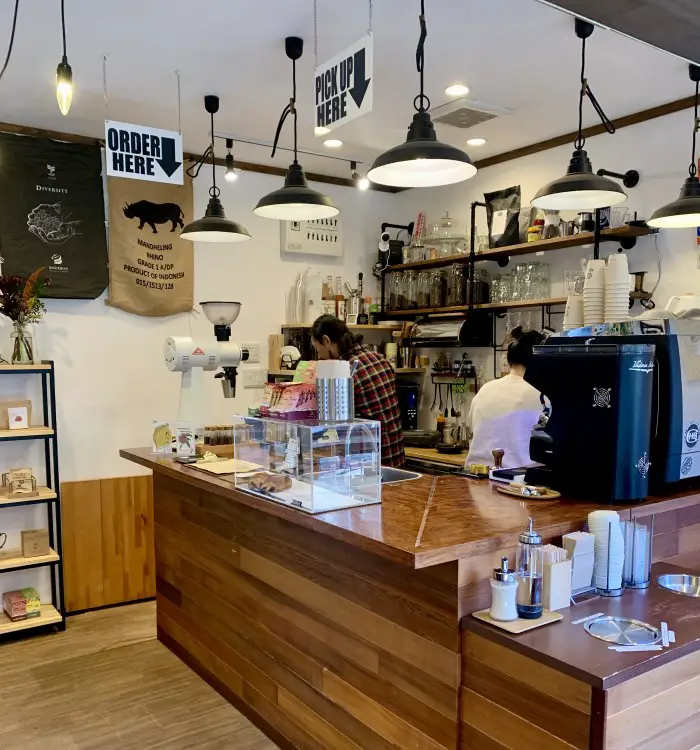
HAGINOYA
Haginoya Restaurant offers a kaiseki dinner consisting of several small courses prepared with seasonal, local ingredients in a wonderful traditional atmosphere. The meal is worth every penny, or rather yen 😉 Each plate is a culinary feast and a work of art at the same time. The waiter tries to explain the ingredients of each dish in English, which is not to be taken for granted in Japan. Reserve a table three days in advance. Although the main menu focuses on fish, you can also order a vegan version. The last order is accepted at 7:30 PM.
Menu Booking form Haginoya Restaurant, Magome – Google location
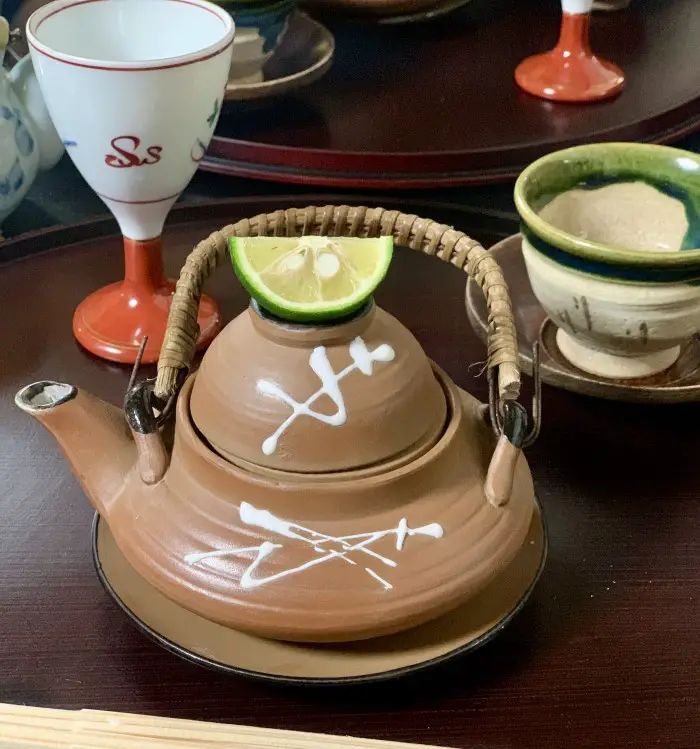
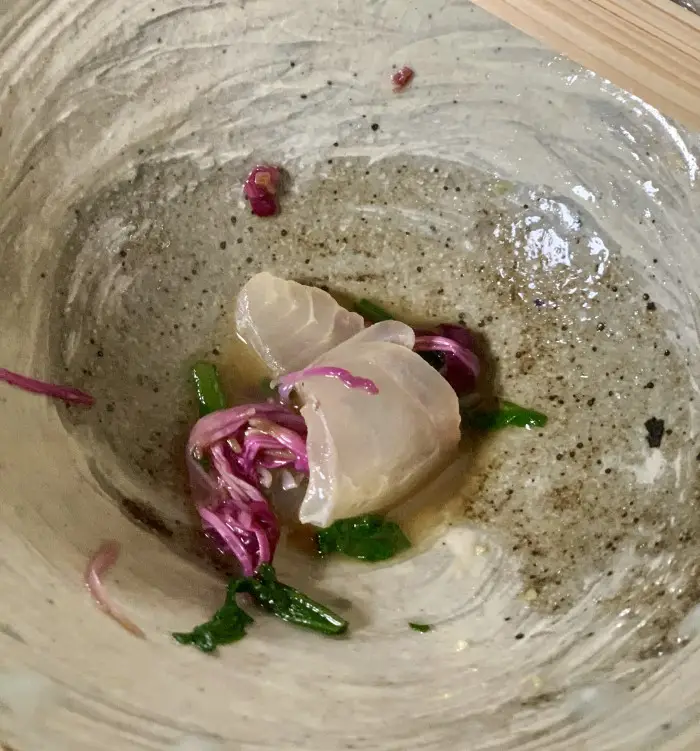
Dinner at Haginoya in Magome was exceptional
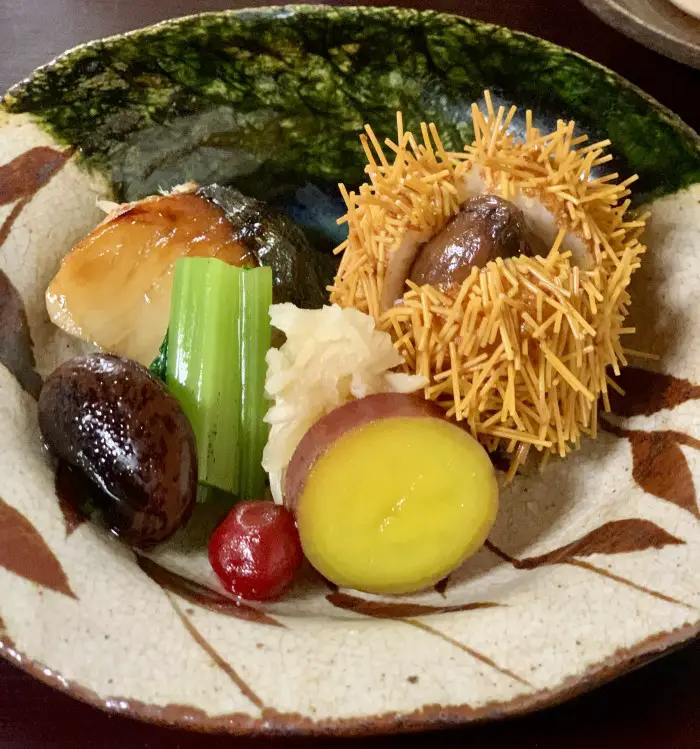

Other available dinner options in Magome, which we did not try:
MIKAZUKIAN
Mikazukian offers soba noodles and tempura served in a stylish, modern interior. In autumn, shabu-shabu courses with wagyu beef and pork are served for dinner. Reservations are necessary and must be made two days in advance. The restaurant is open until 9 PM.
Mikazukian, Magome – Google location
ONTAYA
This is a more down-to-earth restaurant offering typical Japanese staple foods, including ramen, udon, beef curry, and charcoal-grilled rice balls. According to Google reviews, there are several options available for vegans and vegetarians. Dinner table reservations are required and can be made using a QR code (ask for it at the hotel). Orders are accepted until 8 PM.
> DAY 2: Hiking from Magome to Tsumago
Hiking to Magome Pass
After a delicious breakfast at HillBilly Coffee Company, we wandered around charming Magome for over an hour. We bought some oyaki – a great snack “for the road” (a type of dumplings with local vegetables, a typical delicacy for this mountainous area), we probably entered all the souvenir shops and couldn’t get enough of the mountain view with the great massif of Mount Ena from Magome lookout, that’s how it was beautifully!
Views of Mount Ena from Magome lookout
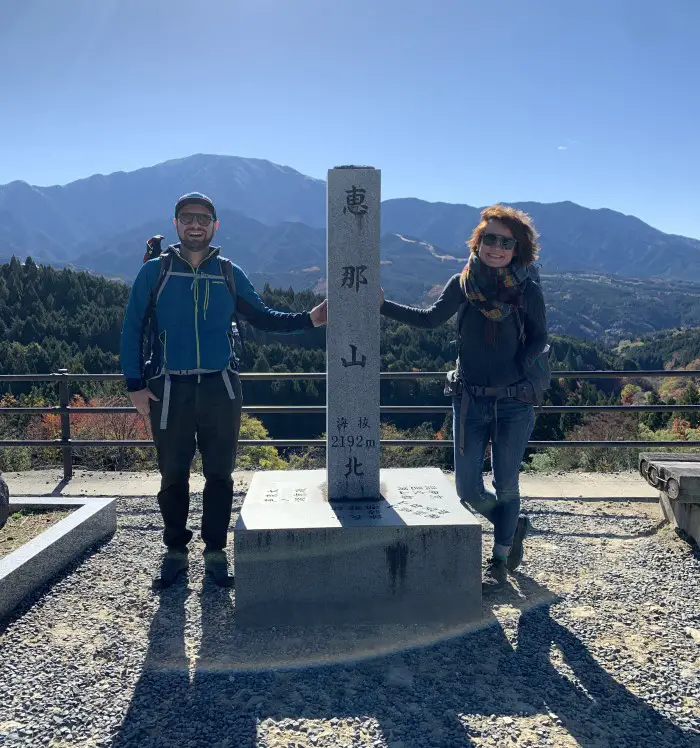
Magome Lookout – Google location
Finally, around 11 AM, we started the 8-kilometre hike to Tsumago. The trail was busy but not too crowded, and the ascent to Magome Pass was very gentle. The blue sky contrasted with the red maple leaves and green bamboo lining the path – it truly was a perfect day for a hike! After 50 minutes we were already on the pass at an altitude of 790 m. We couldn’t believe that we had reached the highest point of the hike so quickly!
Descending from the pass, we entered a 200-year-old teahouse, built in the middle of the trail between two post office towns as a rest stop. It is still an ideal place to rest. We also rang bells countless times to scare away bears on the trail. The trail took us to the lovely Odaka (male) and Medaka (female) waterfalls before turning into a picturesque stone path just before reaching the first historic houses in Tsumago.
Hiking Nakasendo Trail from Magome to Tsumago

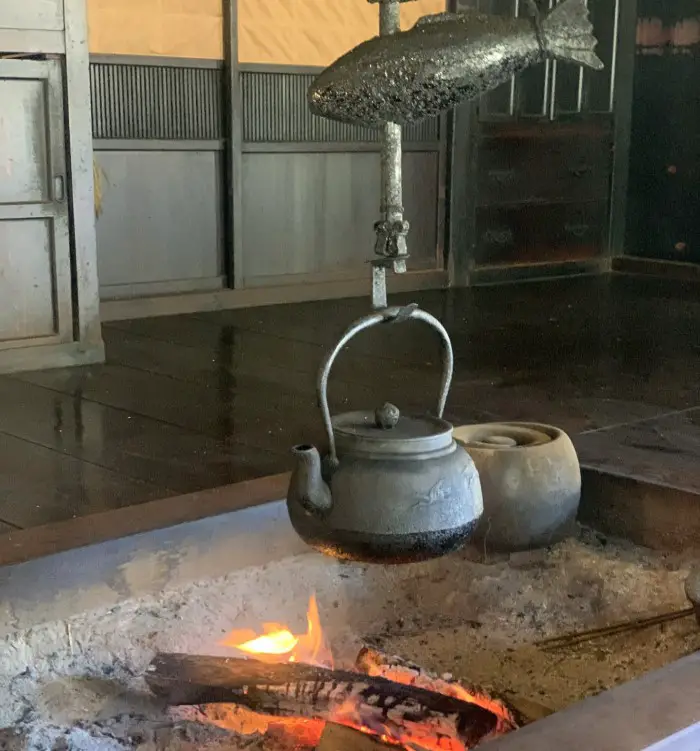
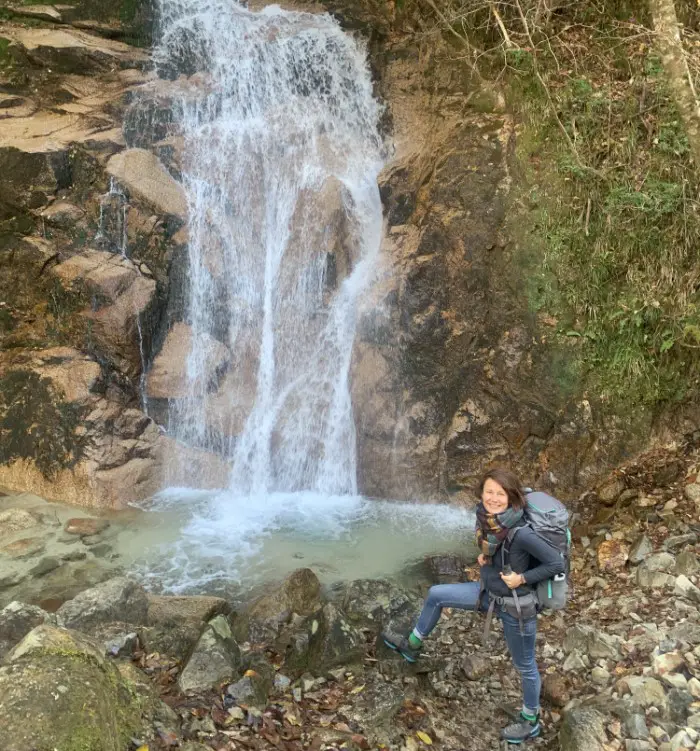
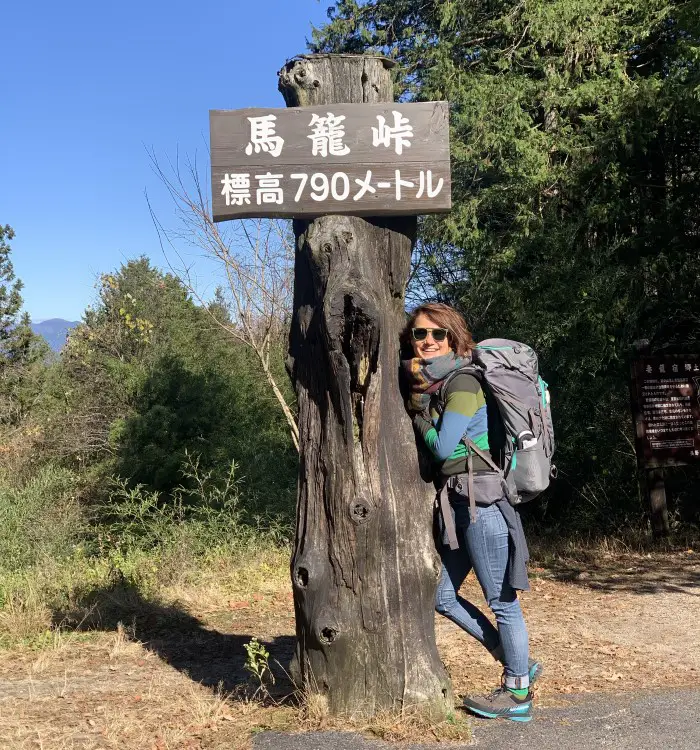
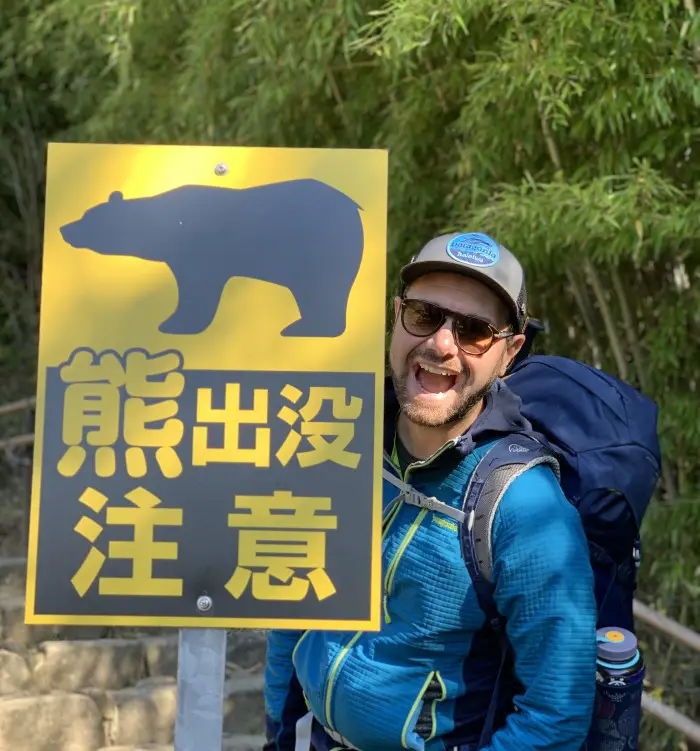
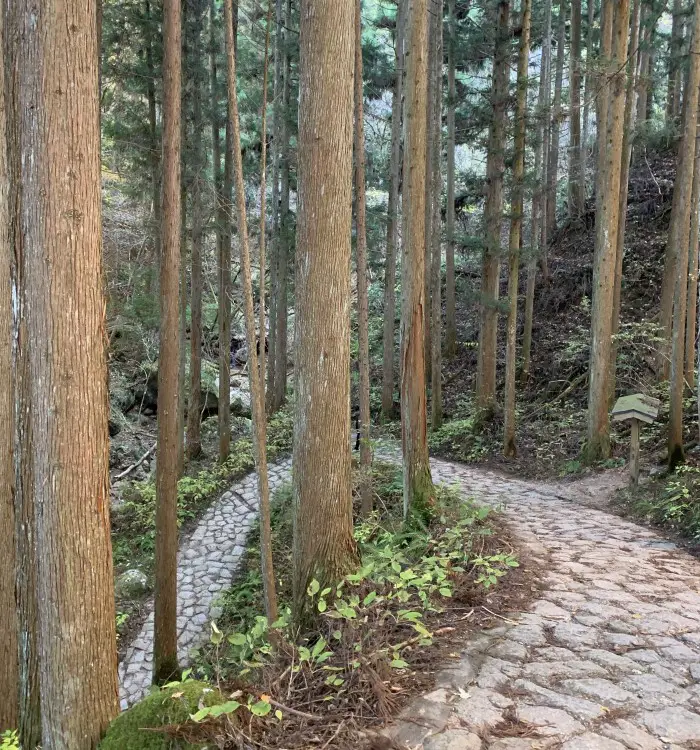
>> Tsumago travel guide
What to do in Tsumago?
Although the atmosphere of the Edo era has been perfectly recreated in the historic town of Tsumago: by banning cars and hiding cables underground, the residents still lead normal, everyday lives here. The wooden houses along the main street have been beautifully restored.
Wooden houses of Tsumago
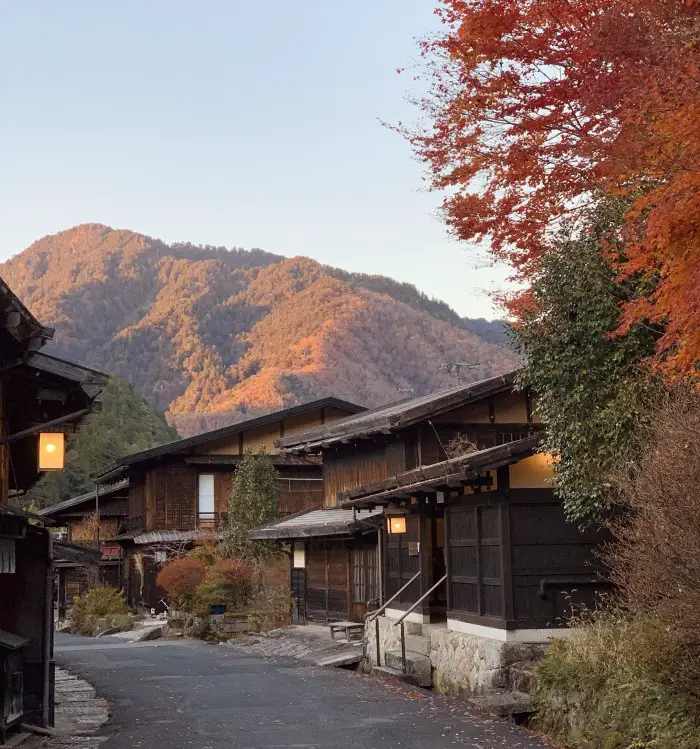
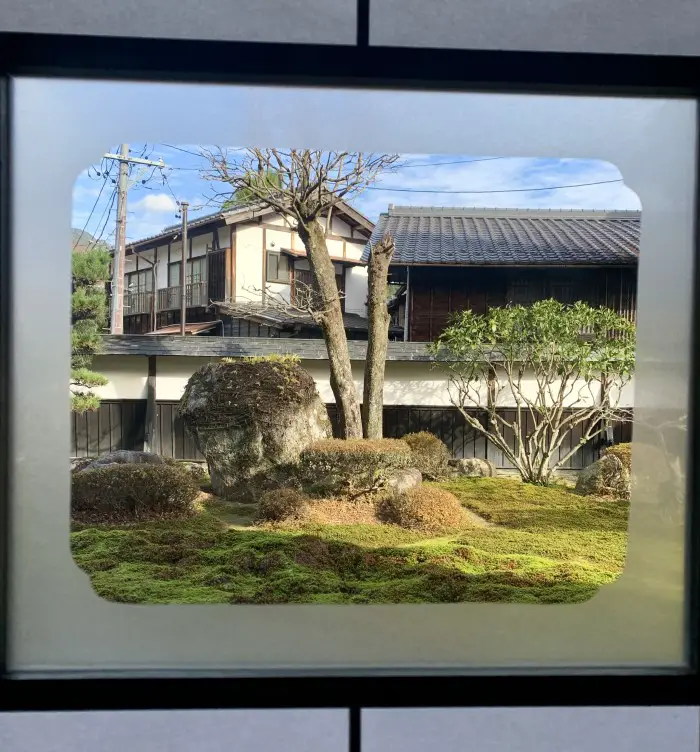
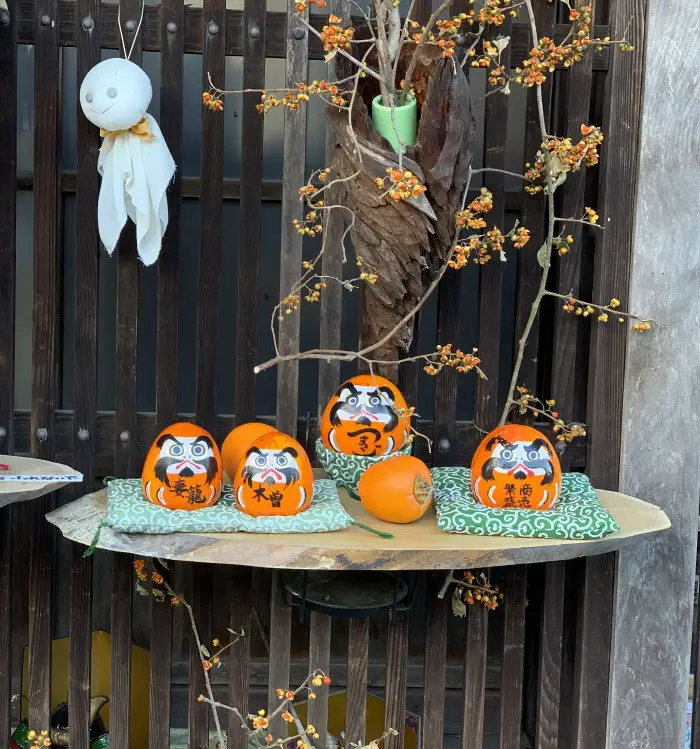

The main attraction in Tsumago, aside from strolling through the streets and soaking up the atmosphere, is visiting the most important historical inns – Honjin and Wakihonjin to see their interiors. The majestic Wakihonjin, built entirely with Japanese cypress (hinoki), is particularly famous among photographers for the beautiful effect of the rays of light falling over the kitchen hearth.
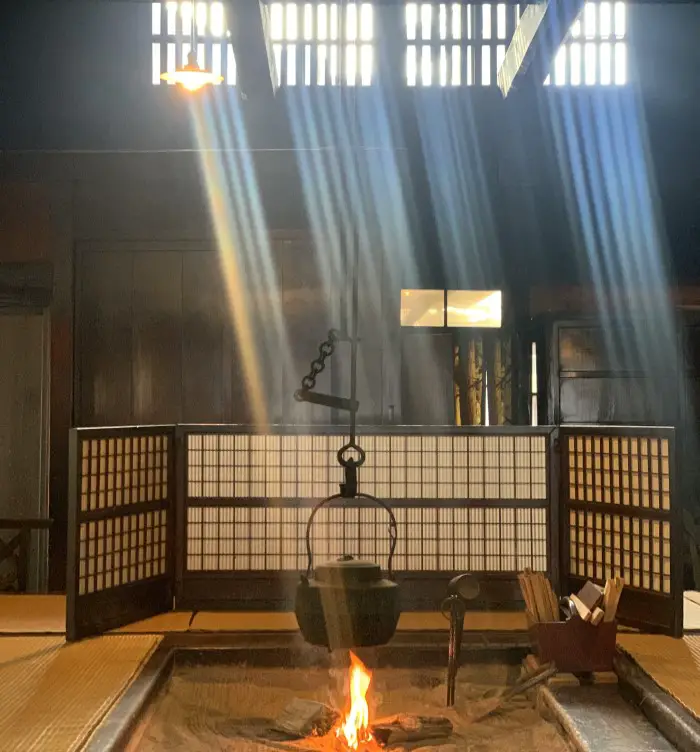
The beams of light can only be seen in winter (Dec-Feb) at certain times of the day. Since we visited the Wakihonjin in Autumn, they were not at their peak.
>Where to stay in Tsumago?
Staying in a traditional minshuku, which is a family-run guesthouse, is one of the highlights of the Nakasendo trail. Be sure to book your accommodation in advance as places are limited also in Tsumago. We stayed in one of the traditional inns – Shimosagaya – offering modest tatami rooms and shared bathrooms, which is completely normal in Japan. This centrally located traditional inn has been restored to reflect a typical Edo-era house.
Both our room and dinner were very authentic, so if you want to experience the charm of traditional old Japan, Shimosagaya is a great option!
You can check prices for accommodation and meals on the website, but reservations must be made by phone. Please note that the owners of the guesthouse speak rather little English, which adds to the authenticity of your stay in Tsumago.
The Inn's Entrance hidden in a little alley, our Modest room & the dinner feast

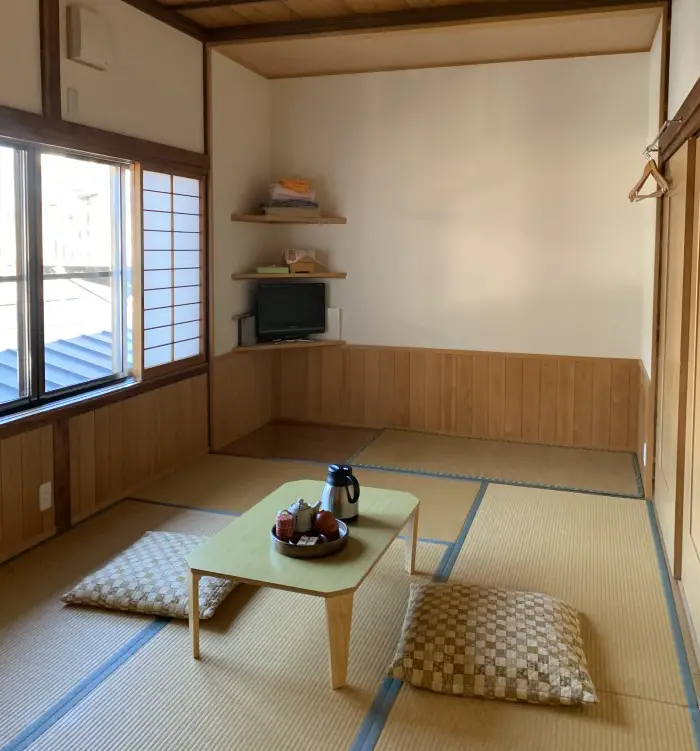
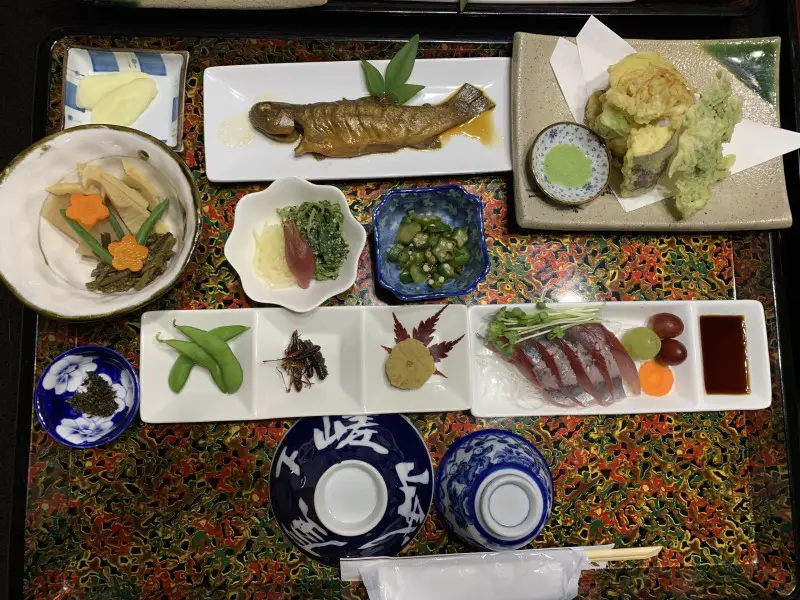
Where to eat in Tsumago?
The number of restaurants in Tsumago is probably even more limited than in Magome. However, if you choose to stay overnight in Tsumago, your minshuku will most likely also serve meals. We decided to have a traditional dinner at the hotel and ate breakfast in a cafe right next to our guesthouse. Kojitsu Coffee serves good coffee and amazing galette pancakes!
Those Galettes in Tsumago are to die for!


> DAY 3: Hiking from Tsumago to Nagiso and from Yabuhara to Narai
Most people take a bus to Nagiso Station, from where they take a direct train to the last gem of the Nakasendo trail in the Kiso Valley – the city of Narai. However, we chose a longer and more interesting route to explore the off-the-beaten path.
The 4-kilometre hike from Tsumago to Nagiso takes less than an hour and allows you to discover the less touristy part of Nakasendo Trail. Be sure to check the train timetable, as trains towards Matsumoto, stopping in Yabuhara and Narai, do not run very often. We took the local train leaving at 10:19 from Nagiso and an hour later we were in Yabuhara, another former post office town.
On the way from Tsumago to Nagiso
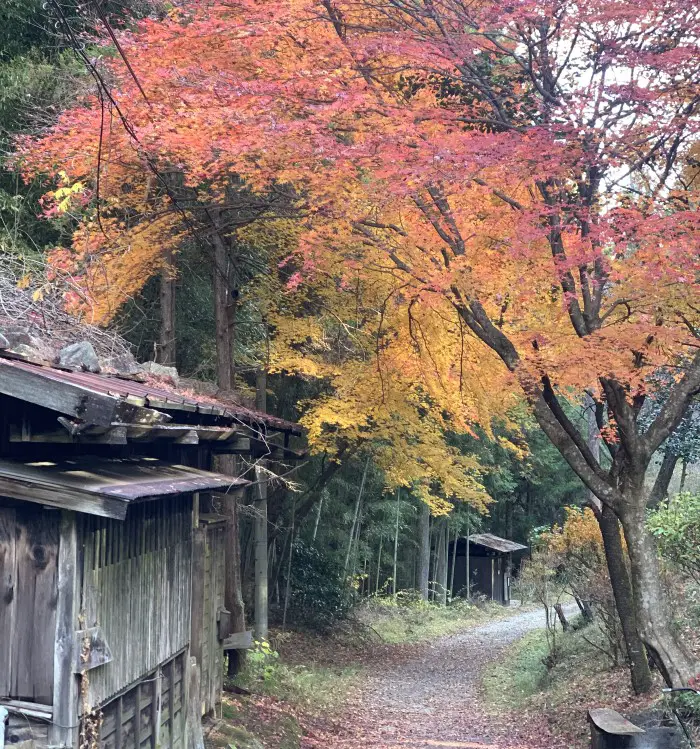
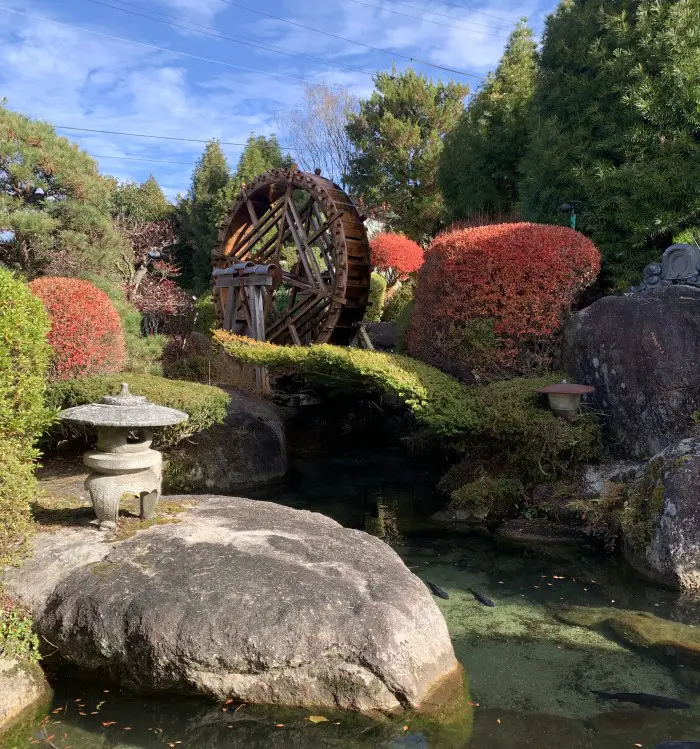
From Yabuhara we set off to the Torii Pass (1179 m) to reach Narai-juku in the traditional way – on foot. The forest hike with a gentle approach took us 2 hours. The Toriitoge Ontake Shrine located on the pass is a truly magical place to take a deep breath and relax surrounded by the mountains. This section of the Nakasendo trail was by far the most serene; we only met a few other hikers.
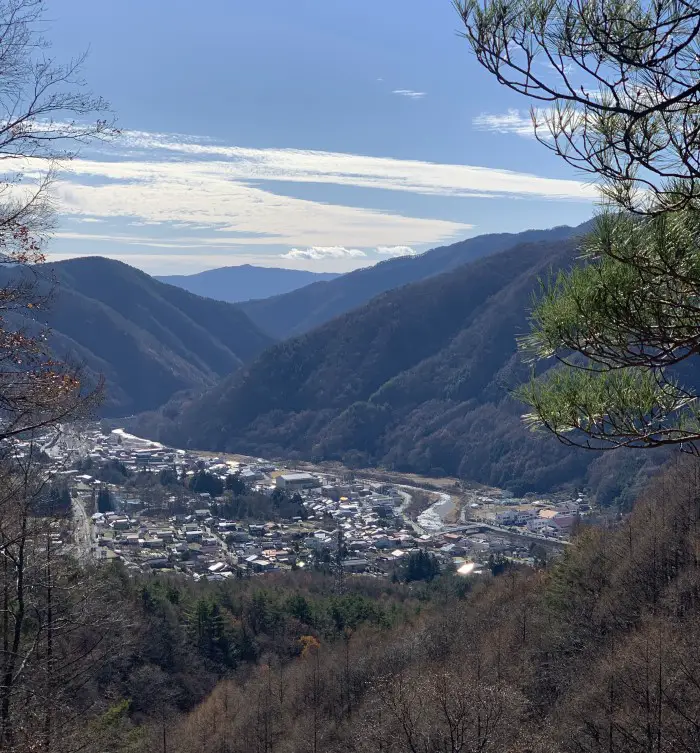
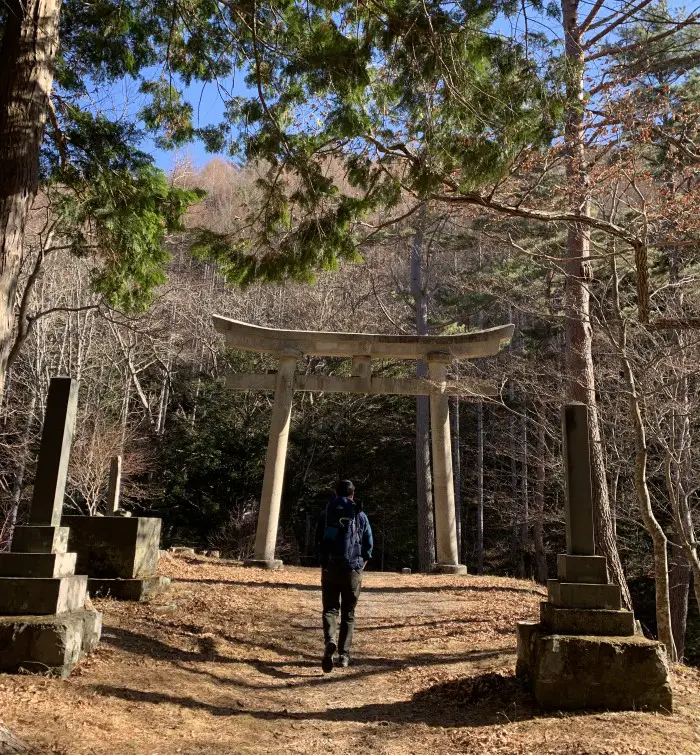
I realised that by visiting the less frequented by tourists former post towns, like Yabuhara-Juku and Ochiai-Juku, you can appreciate how beautifully restored Magome, Tsumago and Narai have been, which is important to fully experience the uniqueness of the Kiso Valley and your hike.
the lack of cables overhead and the wooden architecture in the restored post towns are so pleasing to the eye
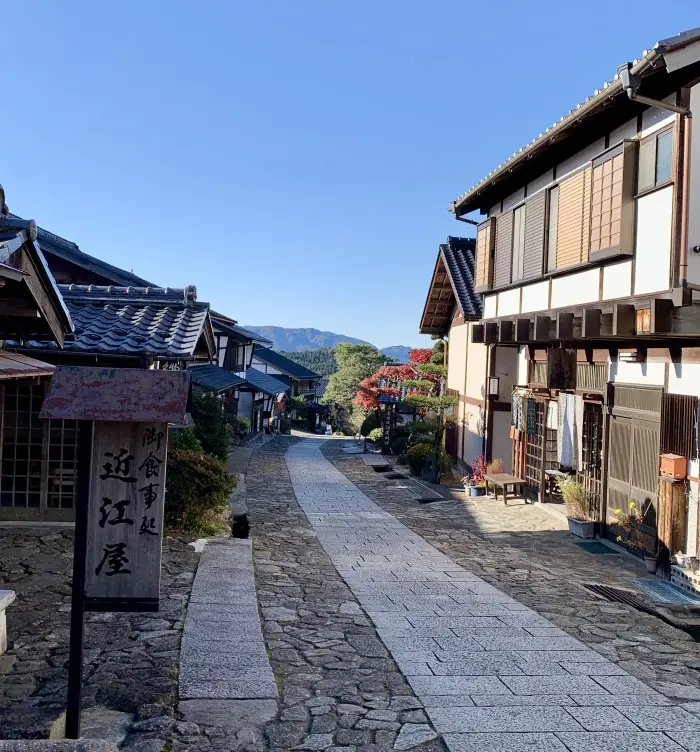
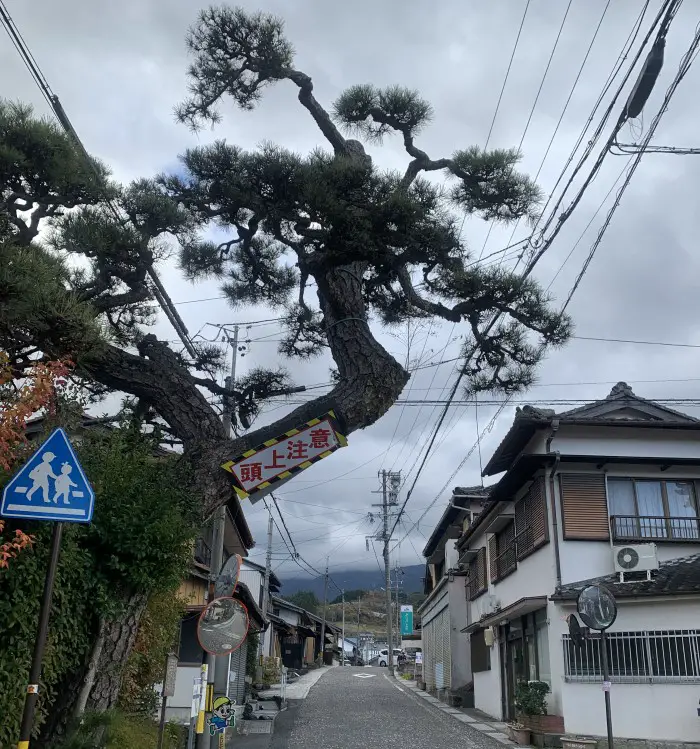
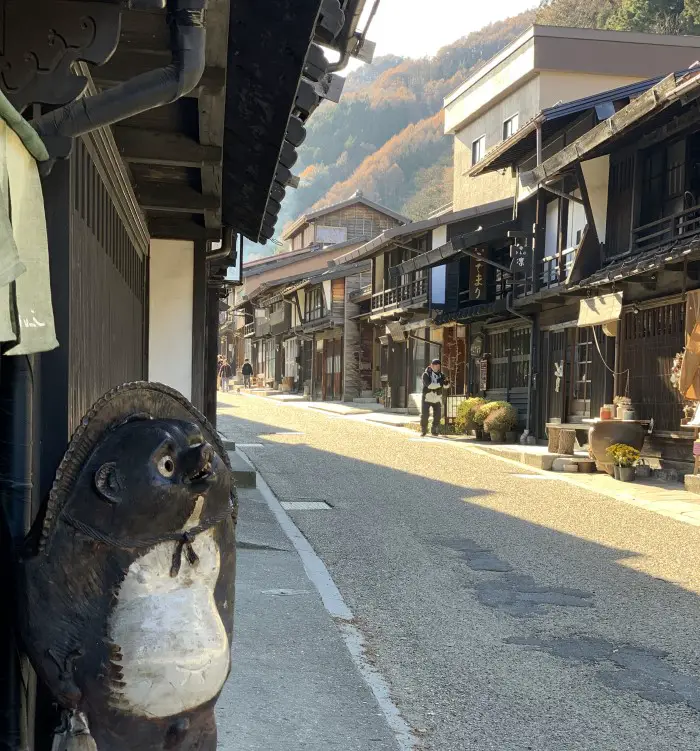
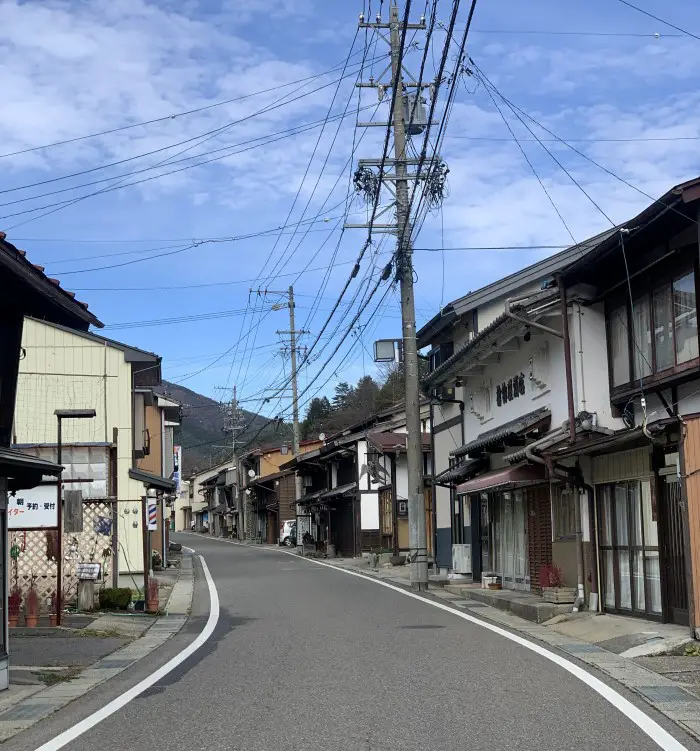
For those who have limited time, a direct ride from Nagiso to Narai, the next station after Yabuhara, will probably be a better idea.
>> Narai travel guide
Due to its strategic location, Narai-juku became the richest and largest post town in the Kiso Valley during the Edo period. Located exactly in the middle of the Nakasendo route between Kyoto and Edo, it has quickly earned the nickname “Narai of a Thousand Houses”. Beautifully restored wooden houses now host souvenir shops, restaurants and minshuku. The selection of everything in Narai-juku is greater than in previously visited post towns, as the main street stretches for about a kilometre. After a short visit to the Shizume Shrine located at the entrance to the city (if you are coming from Torii Pass), we stopped for lunch.

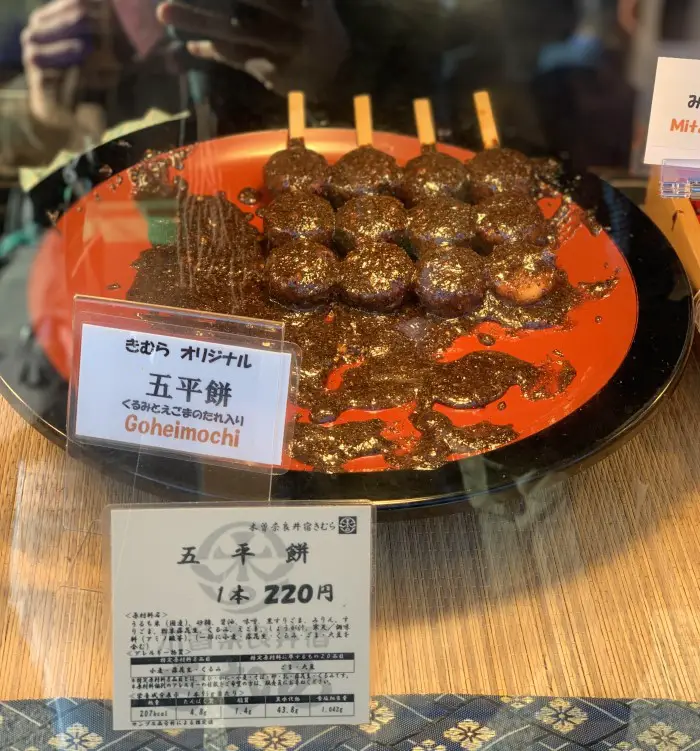
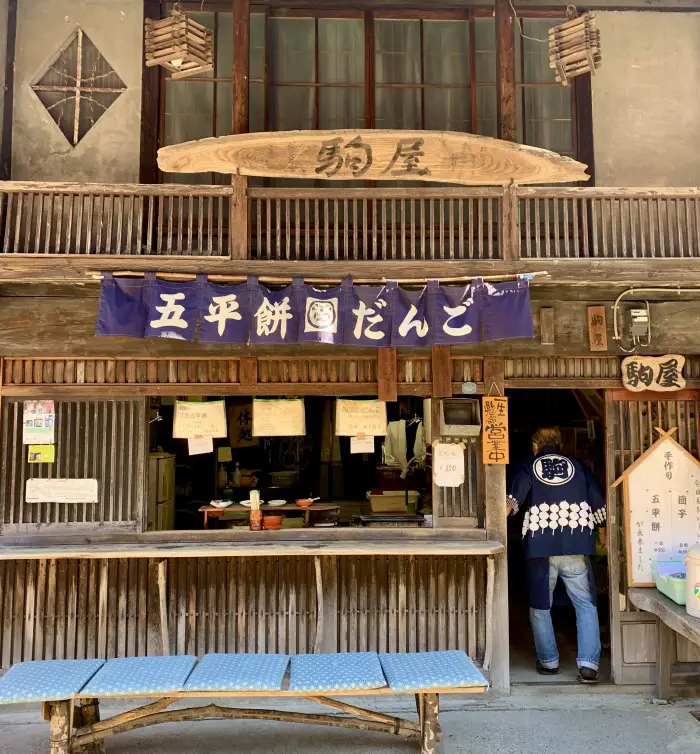
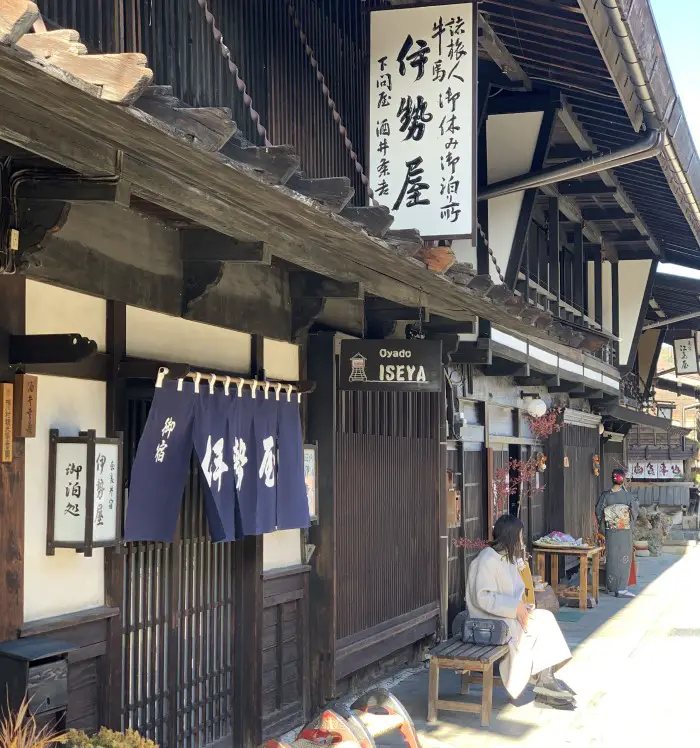
What to eat in Narai?
Craving for traditional mountain buckwheat soba noodles, we chose – according to some Google reviews – the oldest restaurant in Narai – Echigoya. The noodles were delicious, the beer cold, the decor of the restaurant straight from a previous era, and the grandma serving the pasta was friendly. Highly recommended!
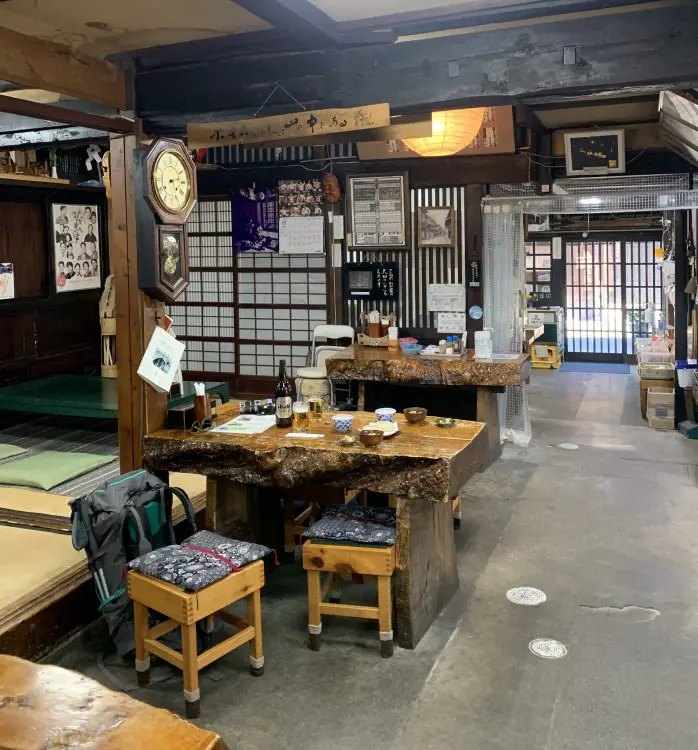
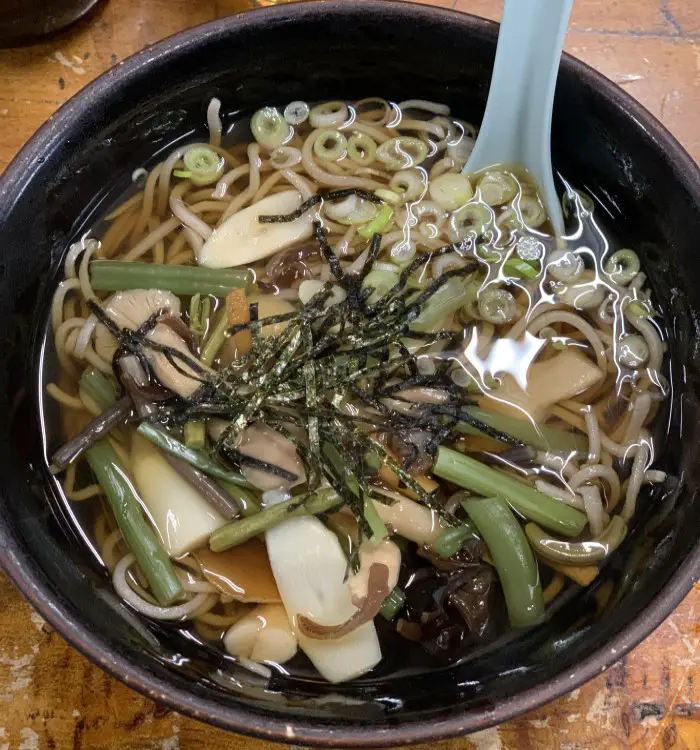
越後屋食堂 – Echigoya – Traditional soba noodle shop in Narai-juku
After lunch, with full bellies, we walked along the main street, taking lots of photos, until we finally found ourselves at a charming cafe that also reflected the atmosphere of a bygone era. In the Matsuya cafe, coffee is brewed using a syphon, and in a 200-year-old building filled with antiques, various cakes are served by a very distinguished elderly couple. It was a truly perfect end to our 3-day hike along the Nakasendo Trail.
Return to Tokyo or Nagoya/Matsumoto
Most shops and restaurants in Narai-juku are open until 4-5 PM, so it is worth planning your return trip to Tokyo (or Nagoya or Matsumoto) for this time. We boarded the local train at 4:57 p.m. and arrived at Shiojiri Station in less than half an hour. There we transferred to the Limited Express train to Shinjuku. The total journey from Narai to Shinjuku took just over 3 hours – not too long considering we traversed two different worlds.
NAKASENDO TRAIL MAP
I hope you enjoyed reading about the Nakasendo Trail. If you have questions or need more information, don’t hesitate to leave a comment. I’ll be more than happy to help! And if you found this article helpful, please leave a comment – your feedback always brings a smile to my face! 🙂


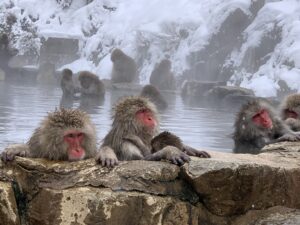
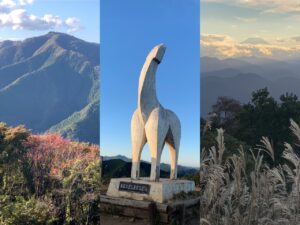
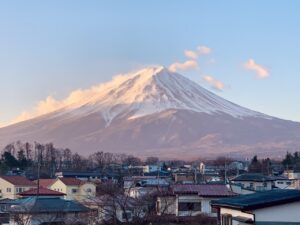
Loooove it
Hello Friend 🙂 Masz też wersję po polsku jakby co 😉 No i dziękuję!!
Fabulous description of your journey. Thank you so much for the details!
Hello Sharon, thank you for such a nice review. You made my day start great 🙂
thank you for sharing.
Always my pleasure to share the beauty of Japan 🙂
Thank you SO MUCH for this precious informaiton
Hi Lysanne, I’m so happy you found it useful and thank YOU for reading!
This looks great! I would enjoy adding this to my/our itinerary! Would tandem nicely with the biking at Lake Kawaguchi!
Can’t agree more! 🙂 Here is a bit about cycling around Lake Kawaguchi: https://betifulworld.com/how-to-fall-in-love-with-mount-fuji-lake-kawaguchi-in-2-days/
Hi Beti, did you do this ‘independently’, making your own accommodation bookings, or did you do this ‘self guided’ through an agent. Having only done ‘tramping’ in New Zealand, where you carry in your gear, looking at ‘self guided’ tours seems incredibly expensive.
Hi Pam & David! I made all bookings myself and carried all my gear. I never used any agent for hiking in Japan. Okay, once I did – when climbing Mount Fuji off-the season, but that’s a different story. You can easily plan yourself hiking the Nakasendo Trail and it does not have to be expensive at all. Hope it answers your question.
Hi this is such a great encouraging description – thank you. What is the best source for booking accommodation and can it be booked in advance e.g. November. Also best site for bus timetables – we would be coming and returning to Tokyo.
Hi Mally,
First of all, thank you for reading my blog. To answer your question – I always try to use first Booking.com to book my accommodation in Japan. If there is nothing I like on Booking.com I search Google Maps for locations/places to stay that fit my itinerary. Some of the more local hotels / smaller ryokans / minshuku = Japanese guesthouses are not available on online platforms so I check their websites and book directly.
As for the buses – I also start my research from Google Maps. It would usually give you the route options and also the name of the bus company (at the bottom) with the link if you need more details about the bus – timetable etc. Those websites are always in Japanese, so open them in Google Chrome and use Google Translate.
Hope it helps. Enjoy your adventure – November is simply the best for Nakasendo Trail!
Beti
This is such an informative and helpful post – the best among all blog posts about the Nakasendo Trail I have come across! I don’t leave reviews on travel blogs but I really appreciate your efforts! Thank you!
Hello Tuan, you can’t imagine how nice is to receive words like yours. I don’t post too often, but when I do, I put all my heart and knowledge into writing, and I am so happy if someone appreciates it. Thank you!
What an incredible experience! I rarely follow a travel blog word for word, but this one I was totally compelled. All the instructions and experiences were spot on and exactly what we wanted from our short time in Japan – thanks Beti!
Using the luggage forwarding was a game changer, as we dit the whole walk from Tsumago to Narai in one day. The couple of providers we checked with were very response and flexible. I have done a lot of walking in NZ and thought it couldn’t get easier than that…turns out it can. Every time we wondered about the next turn, a sign popped up.
Thanks for putting all the effort and detail into this itinerary, it worked brilliantly. Now onto the next trip planning!
Hello Friend 🙂 I’m so happy my little blog was useful, you’ve enjoyed this beautiful hiking journey, and so glad we had a chance to catch up in Tokyo. Thank you for your feedback – I know you don’t follow blogs and leave comments, so it means the world to me! Xx
Hi Beti, this 3D 2N plan is great! Which provider did you use to forward your bags from Nakatsugawa to Magome, then Tsumago, then finally to Nagiso? I plan to stay 1N at Magome and 1N at Tsumago. Thank you!
Hi Grace! Thank you for reading my blog and your comment. So happy you found it useful. I travelled light and carried my backpack with me, so I can’t recommend you any provider in particular. However I heard all of them are pretty responsive and flexible. Good luck!
Hello ,
“We took the local train leaving at 10:19 from Nagiso and an hour later we were in Yabuhara, another former post office town.”
I would like to avoid trains if at all possible. Is it possible to hike from Nagiso to Yabubara? If so, what is the extimated time?
Thank you for your detailed information.
David
Hi David!
There are a few post towns (listed below) between Nagiso and Yabuhara and, according to Google, the distance connecting those two post towns is around 50 km.
35. Yabuhara-juku
36. Miyanokoshi-juku
37. Fukushima-juku
38. Agematsu-juku
39. Suhara-juku
40. Nojiri-juku
41. Nagiso (Midono-juku)
As far as I know the 15-km Nagiso-Nojiri route is a beautiful hike through the countryside and forest, which you can try and Fukushima-juku is an interesting town to explore.
Apart from that, I’m not sure how pleasant hiking from Nojiri to Yabuhara would be. Although it is possible to hike the entire Nakasendo Trail from Kyoto to Tokyo (Edo) and pass through 69 post towns, most of the trail has been replaced by roads.
Hope my answer helps a bit. Good luck with planning! And thank you for reading my blog!
Beti
Thanks so much for this lovely itinerary, and the reassurance that it will be possible in November. If it is anything like hiking through Himalayan villages (which I have done), then I am in! I was hoping to include Magma-Tsumago walking during my solo trip later this year but now you’ve inspired me to expand the walk to include the other sections you’ve covered.
Hi Linda, thanks for your lovely comment! It always makes me very happy to know my writing helped or even inspired someone <3 Magome has a bit of a Himalayan feel to me. I'm so curious to know how you like it. Enjoy your trip!
Hi Beti,
Thank you for such and informative blog. It is very usefull now when I am planning my trip to Japan.
I am planning to hike this route but would like to do it opposite direction Narai – Nakatsugawa.
Do you have any input or feedback if vice versa is also OK to do? Could there be any limitations in train times, etc.?
I want to do like this because I want to go to Narai from Tokyo while ship my bags to Kyoto, finish the hike in Nakatsugawa and go from Nagoya to Kyoto.
Hi Lelde,
I am so happy you found my blog useful and thank you for such a lovely comment. I don’t see any difference in doing the hike in the opposite direction when it comes to transportation. Go for it! 🙂 If you are heading to Kyoto afterwards, that’s the only right direction. Enjoy your Japan adventure!
Hi Beti, thanks for this very helpful blog post! My partner and I will be traveling to Japan for the first half of November and I was hoping to spend part of that away from the cities, and this looks like a great option. Hopefully we can still find available accommodations. My question is: What would you recommend we do with the luggage that we don’t want to take on the multi-day hike? We were thinking perhaps a locker situation in the train station in Nagoya? Any info or recommendations you can offer would be appreciated!
Hi Lia!
Thank you so much for reading my blog and for finding it useful. I really hope you will find the accommodation! Novemeber is a fantastic time for Nakasendo!
As regards luggage you have plenty of options. Not sure if at Nagoya Station you can leave your luggage for multiple days or need to pick it up within 24 hours. You will have to check it out find lockers/services that allow you to do it. I’m sure that they exist but have no experience myself.
You can also ship your large luggage to your next destination using your hotel’s luggage shipping service (for example from Nagoya to Matsumoto), which is a very popular option among tourists, but of course it depends on what kind of accommodation you are staying.
You could also directly send it through YAMAMOTO https://www.global-yamato.com/en/hands-free-travel/
You could also use Nakasendo luggage forwarding service: https://magome-luggagetransport.jp/ Some of the hotels on Nakasendo Trail also have such services.
I hope it helps bit. Good luck with your adventure!
Hello, did you have to book your train ticket online in advance from Nagoya to Nakatsugawa? Or is it safe to buy it at the train station? Thanks!
Hi Grace, we bought it at the station. I reckon it’s safe! Happy hiking!
Hello,
Many thanks for your excellent detailed account of hiking the 3 day self guided Naksendo trail . Could you please advise on the train timetable from Narai to Nagoya. I understand that the local trains from Narai are infrequent and also the timimg of transfering onto the regional train onto Nagoya.
Is there any price difference if we buy the train tickets in advance or does the price stay the same irrigardless of when purchased?
Many thanks in advance
Jill
Hi Jill! Thank you for your kind words. I am so happy you found my article useful. As for the timetable please check the train connection time on Google Maps. It is very reliable and easily available. For local/express trains there is no price difference if you buy tickets in advance. When it comes to shinkansen, you might get a discounted tickets if you buy them before. Hope it helps. Good luck and safe travels!
thank you so much for the rich information. i only plan to hike two days. Can i combine the first two days? Or should i return to Nagoya from Tsumago after the second day? What is your suggestion for a two day itinerary? Thanks. David
Hi David, thank you for reading my blog and leaving a comment. It always makes me very happy 🙂
Regarding your question, if I were you, I would start with checking what accommodation is available. It’s often hard to find a guesthouse in Magome and/or Tsumago as they tend to be booked out quickly, so I would decide if I combine Day 1 + Day 2 or Day 2 + Day 3 (both options are possible) based on the location I stay overnight. Most of the relatively fit people are able to complete this hiking route in 2 days, but if you want to shorten it, I would skip hiking from Yabuhara to Narai and would take a train instead. I hope it helps. Good luck and Happy New Year!